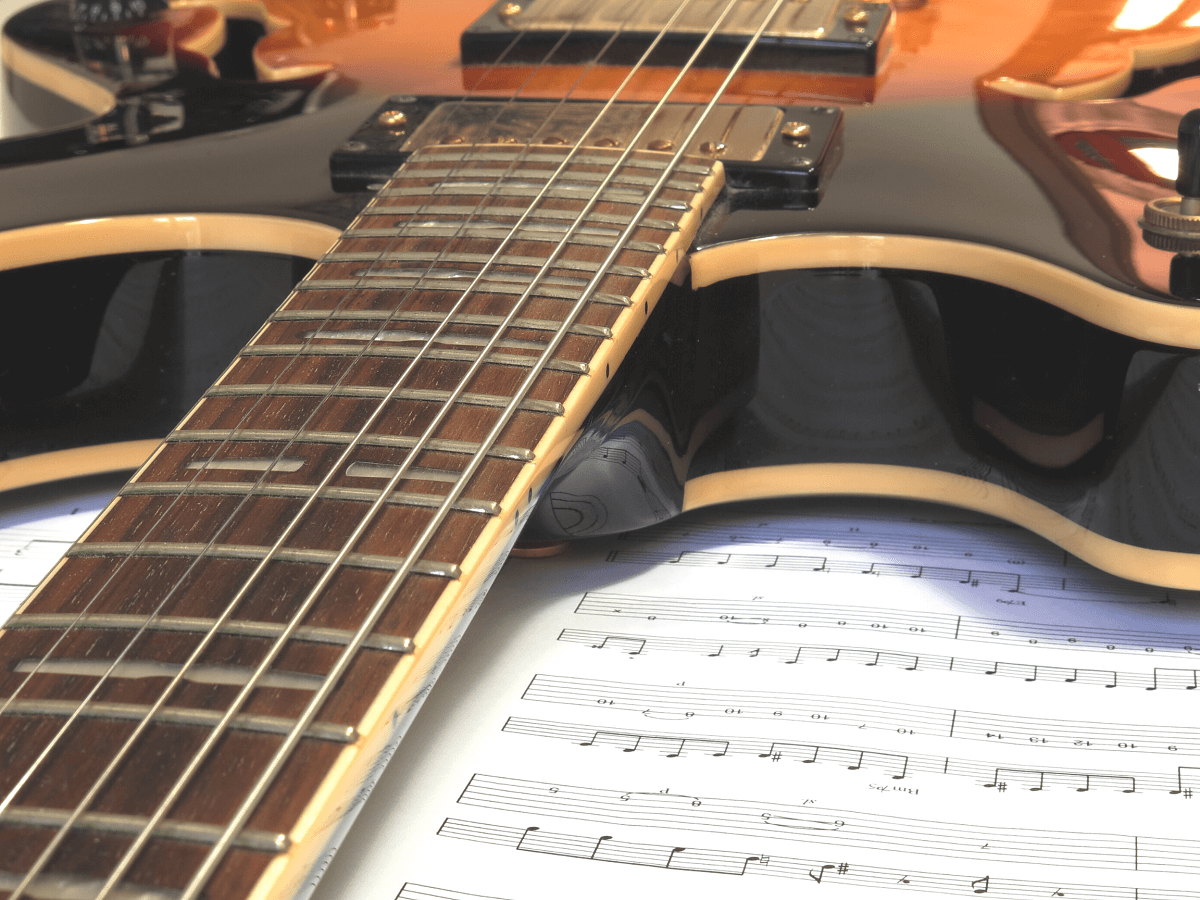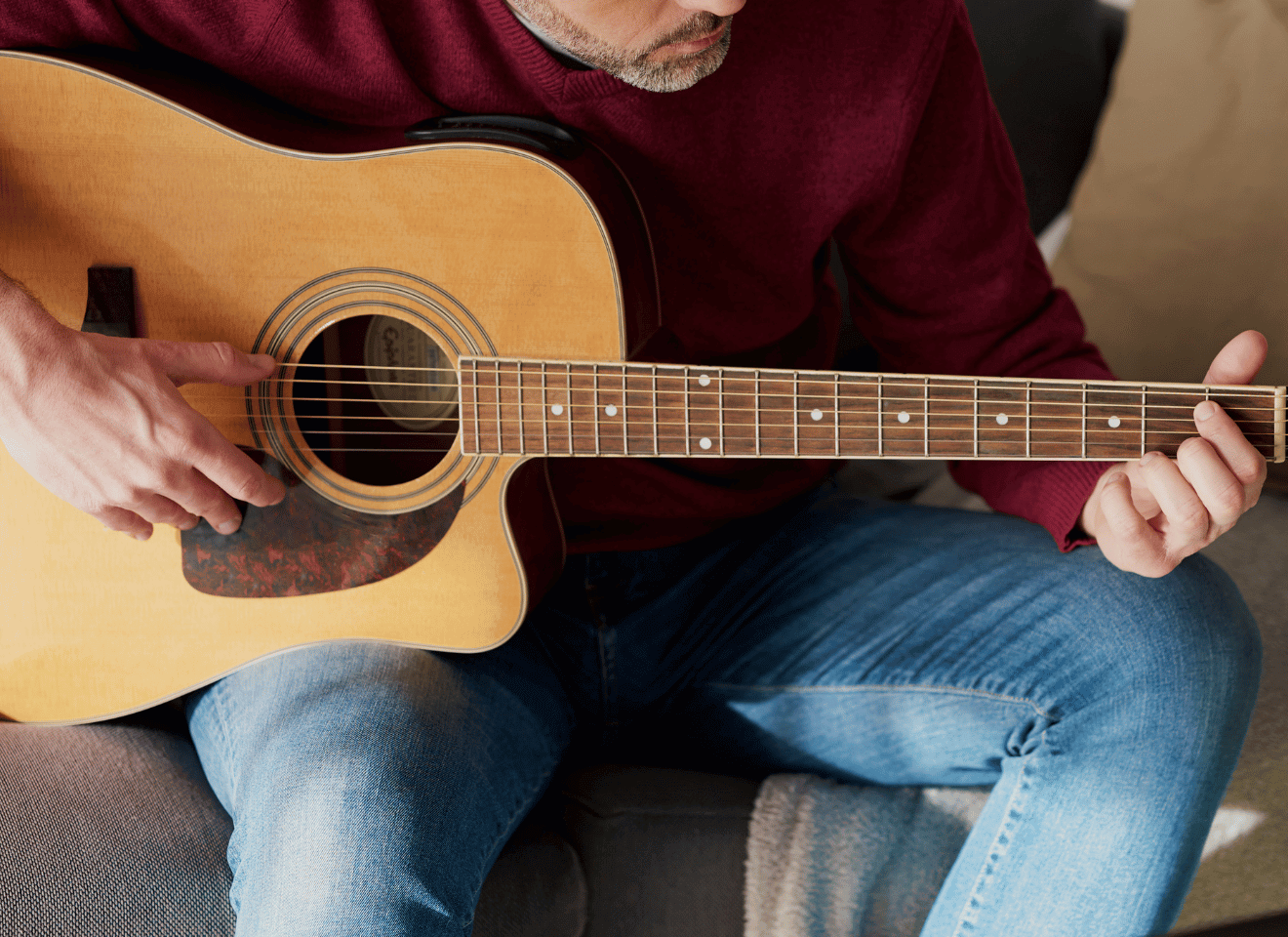There’s no denying the role of a quality instrument in the hands of a seasoned musician.
Perfection in sound production, the feel of the fretboard, the balance of the guitar, all these and more can revolutionize a performance.
A finely crafted acoustic guitar not only enhances the dexterity of the player but aids in creating rich and layered music that can truly enchant the audience.
The market is filled with countless options, hence, selecting the right one can pose a challenge, especially for seasoned professionals who seek nothing but the best.
This article is curated to reduce this daunting task of making a choice and will present a comprehensive analysis of each shortlisted product.
Focusing on the top-notch acoustic guitars currently available, we will delve into detailed reviews encompassing the pros and cons, features, and build quality of each instrument.
Table of Contents
- Best Acoustic Guitars For Professionals
- Breedlove Oregon Concerto CE Acoustic-Electric Guitar
- Taylor Koa Series K24ce Grand Auditorium Acoustic-Electric
- Martin D-28 Modern Deluxe
- Larrivee L-09 Acoustic Guitar
- Guild F-55 Maple Acoustic Guitar
- Gretsch Guitars G5022C Rancher Falcon Cutaway Acoustic-Electric Guitar
- Yamaha SLG200S Acoustic-Electric Guitar
- Fender American Acoustasonic Telecaster Acoustic Electric Guitar
- Guild F-250CE Deluxe Acoustic-Electric Guitar
- Takamine EF341SC Pro Series Dreadnought Acoustic-Electric Guitar
- Luna VISTA EAGLE Acoustic-Electric Guitar
- Martin D-45 Natural Acoustic Guitar
- Washburn Woodline Series WLO20SCE Acoustic-Electric Guitar
- Epiphone Masterbilt Excellente Acoustic-Electric Guitar
- Taylor 814ce Acoustic-Electric Guitar
- Blueridge BR-160 Historic Series Acoustic Guitar
- LAVA ME 2 Acoustic-Electric Carbon Fiber Guitar
- What to Look for When Buying Professional Acoustic Guitars?
- How Different Woods Impact the Guitar’s Sound?
- Should You Consider the Brand When Buying a Professional Acoustic Guitar?
- How to Choose the Right Size Acoustic Guitar for Professionals?
- How to Evaluate the Tone Quality of an Acoustic Guitar?
- How To Take Care of Your Professional Acoustic Guitar?
- What Strings Are Best for Professional Acoustic Guitars?
- Does The Shape Of An Acoustic Guitar Affect Its Sound?
- How Do You Know if a Guitar is High Quality?
- The Importance of a Guitar’s Neck Construction?
- The Bottom Line
Best Acoustic Guitars For Professionals
Before I begin, here are my top selected choices:
|
|
LAVA ME 2 Acoustic-Electric Carbon Fiber Guitar

Versatile, lightweight carbon fiber guitar with effects. Check Price
|
Luna VISTA EAGLE Acoustic-Electric Guitar

Innovative design with unique, vibrant wood veneers.
Check Price
|
Breedlove Oregon Concerto CE Acoustic-Electric Guitar
Sustainably crafted acoustic-electric guitar with unique tonewood.
This acoustic-electric guitar is built with sustainable Myrtlewood, Maple and Ebony woods, ensuring high quality and unique tonality. The design features a concert body shape, with a comfortable hand orientation for right-handed players. It stands out by offering an impressive volume and nuanced sound, all while incorporating sound optimization and the brand’s proprietary Cascade bracing.
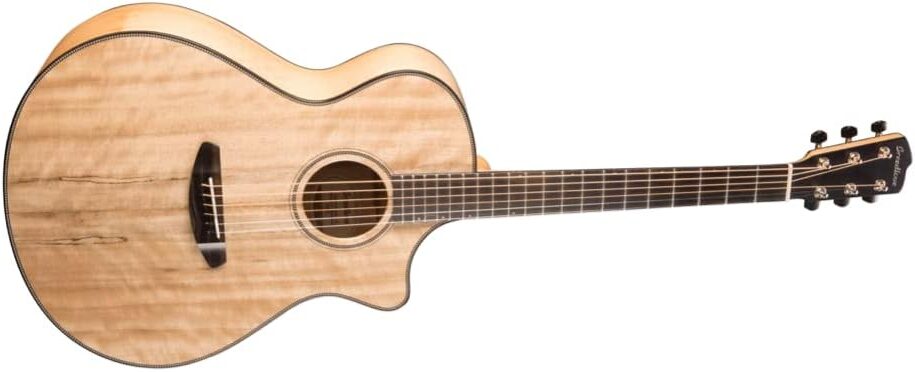
The Breedlove Oregon Concerto CE Acoustic-Electric Guitar showcases a robust 6-string with Natural Myrtlewood as its key characteristic.
Made from Maple Wood and Ebony, it includes a fingerboard, back, and sides that enhance the guitar’s overall aesthetic and playability.
Natural color is its dominant shade, which pairs smoothly with the Myrtlewood top.
Interestingly, the neck of the guitar is crafted from quality Maple wood, and it sports an Ebony wood fretboard.
Moreover, the guitar’s pickup configuration comes equipped with LR Baggs EAS VTC.
The strings are made of Phosphor Bronze, designed primarily for right-hand orientation.
The product is the culmination of the vision of Breedlove, synthesizing science and art into versatile shapes for over three decades, and advocating for sustainable craftsmanship.
Its uniqueness lies in the Sound Optimization process, which accounts for the distinctive densities of wood sets; making no two guitars identical in tonal quality.
The brand utilizes a proprietary hand-tuning process to individually serialize the wood sets, gathering over 40 data points on every guitar.
What sets this product further apart is its use of Myrtlewood, renowned for having the most uniform cellular structure of any wood, translating into an extraordinary tonewood.
Each design is consciously built for on-the-go musicians with its travel size design, providing clear, crisp sound, making it an absolute delight to play.
- My Review
Stepping up to my Breedlove Oregon Concerto CE Acoustic-Electric Guitar, I was immediately captivated by the natural beauty of the myrtlewood top and conservation-minded ethos of the Breedlove brand.
Not only does the myrtlewood top of the guitar offer a remarkable aesthetic, but it also provides harmonic richness, as noted by Cyril Jacobs’ endorsement of this unique tonewood.
As I strummed the instrument, I found the maple and ebony wood construction made a significant difference in the overall sound quality of the guitar, offering a crisp, clear sound that exceeded my high expectations.
My fingers, as they glided over the ebony fingerboard, enjoyed not only its smooth touch but also the exceptional sound optimization that the fretboard offers which clearly showcases the scientific and artistic expertise that Breedlove has honed over three decades.
As a right-handed individual, it was easy to appreciate the guitar’s adaptations made specifically for right-handed individuals, truly making the experience more comfortable and enjoyable.
With every strum, the guitar’s unique LR Baggs EAS VTC pickup configuration demonstrated its value by delivering a warm, amplified sound that retained its natural acoustic qualities.
I also felt the brand’s commitment towards sustainability every moment of playing – the absence of clear-cut wood is something that I, and many other environmentally-conscious musicians, deeply respect.
Finding a brand that manages to combine superior craftsmanship, attention to sound quality and dedication to ecological sustainability, like Breedlove does, really stands out in the crowded guitar market.
The phosphor bronze strings of the Breedlove Oregon Concerto CE Acoustic-Electric Guitar enriched the instrument’s sound further, adding a pleasant metallic tone that allowed each note to shimmer whilst maintaining consistent tonal balance.
The Breedlove Oregon Concerto CE, with its sustainable construction, sound optimization technology, and thoughtful design, has truly made a lasting impression on me.
Perfect for both travel and full-sized concert performances, this guitar exhibits Breedlove’s dedication to creating quality instruments that offer superior sound, ease of play, and compassionate wood sourcing.
- Pros:
- Sustainably built guitar.
- Uniquely designed for good sound.
- High-quality tonewood used.
- Cons:
- Reviews from buyers missing.
- Quite expensive for beginners.
- Only suitable for right-hand players.
My final verdict is that the Breedlove Oregon Concerto CE Acoustic-Electric Guitar – Natural Myrtlewood is a stunning instrument and a worthwhile investment.
The use of sustainable, exceptionally uniform Myrtlewood provides fantastic tonality and its innovative sound optimization design ensures superior sound output.
The naturally-finished Maple and Ebony construction adds a classic touch, while the LR Baggs EAS VTC pickup configuration offers excellent amplification options.
With a bright, balanced tone and dynamic range, this guitar is as versatile as it is beautiful, suitable for both strumming and fingerpicking styles.
Whether you are a professional musician or an enthusiast, the Breedlove Oregon Concerto CE Acoustic-Electric Guitar is a superb addition to any collection.
Taylor Koa Series K24ce Grand Auditorium Acoustic-Electric
Premium Koa Acoustic-Electric Guitar with High-Quality Sound
This stunning guitar boasts Hawaiian Koa top, back and sides, paired with a mahogany neck and fretboard. Equipped with Taylor Expression System 2 electronics, it delivers high-quality sound suited for both stage and studio. Additionally, its beautiful design features maple edge trim, an all-wood Island Vine inlay, and a shaded edgeburst finish, making it visually as well as tonally captivating.
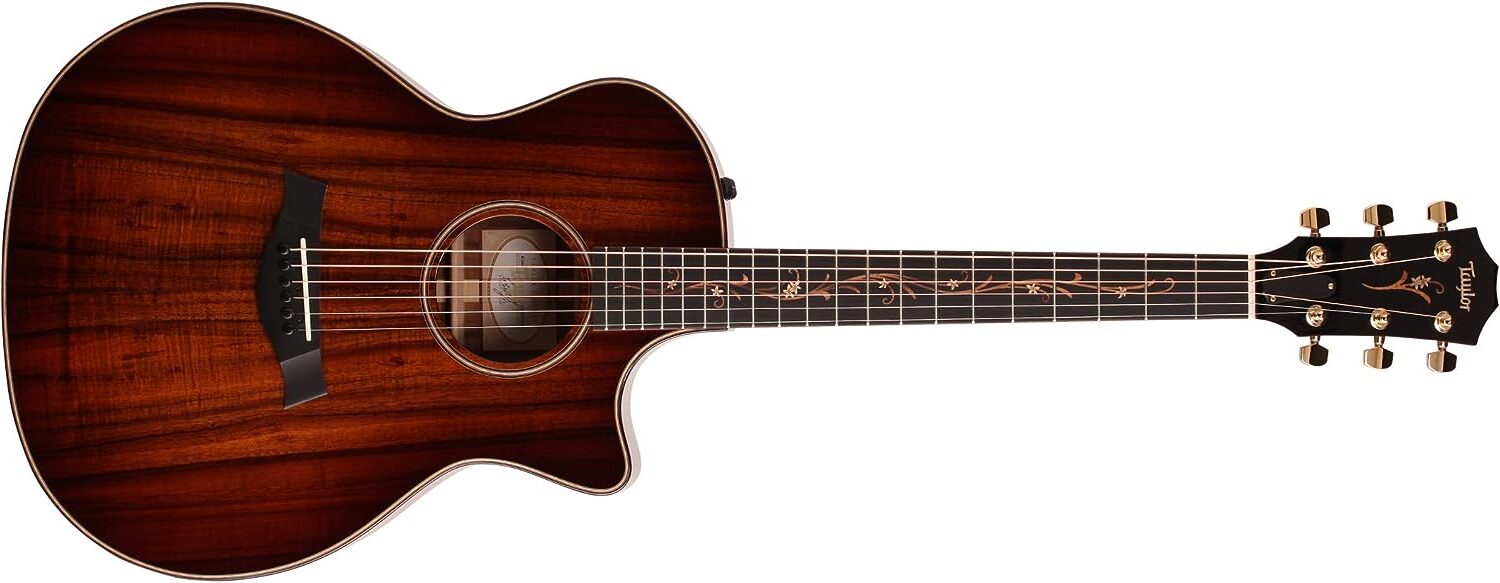
This product is a Taylor Koa Series K24ce guitar, designed with a Grand Auditorium shape for exquisite tonal quality.
Boasting a total of six strings, the guitar presents a balanced use of various woods in its construction.
The back and sides are crafted from Hawaiian Koa, a wood known for its distinct visual allure and resonant sound quality.
This guitar features a 25-1/2″ scale length and a top also made of Hawaiian Koa, resulting in a visually striking and tonally captivating instrument.
Created by renowned brand, Taylor, the guitar showcases a Shaded Edge Burst color that imparts a unique appeal.
The top material consists of Maple Wood and Mahogany Wood, contributing to the guitar’s durability and tonal richness.
Materials used in the body include Mahogany, Koa, and Wood, while the guitar’s back is crafted from Koa Wood for improved resonance.
The neck is made from Mahogany, built for comfort and playability, with a Mahogany Wood fretboard assuring a smooth player’s experience.
Designed for right-handed individuals, this six-string guitar is a versatile instrument catering to players of varied styles.
Taylor K24ce Koa Grand Auditorium Acoustic-Electric Guitar features an all-wood Island Vine inlay on the fingerboard and headstock, maple Taylor logo, and Taylor Gold tuning machines for a truly high-quality and stage-ready appearance.
- My Review
Now, let’s delve deeper into my personal experience with the Taylor Koa Series K24ce Grand Auditorium Acoustic-Electric Guitar in Shaded Edge Burst.
From the outset, its visually striking Hawaiian koa top, back, and sides caught my attention not only for their aesthetic appeal but also for the richness they impart to the overall sound.
Turning it over in my hands, I appreciated the high quality of the mahogany used for the neck and fretboard, which contrasted perfectly with the koa wood.
This intriguing mixture of woods lends the guitar the full-bodied midrange and bright, sparkling trebles that are a defining trait of the K24ce.
As someone who doesn’t compromise on sound quality, I found the Taylor Expression System 2 electronics in this guitar outstanding.
Whether strumming gently or plucking with intensity, the guitar seamlessly produced high-quality sound; a testament to its excellent craftsmanship.
Speaking of craftsmanship, the exquisite detail in the all-wood Island Vine inlay on the fingerboard and headstock reaffirms the guitar’s premium standing.
The use of a tropical mahogany neck shaped into Taylor’s standard profile made for a comfortable grip that enhanced the playing experience.
It was evident that every feature of this guitar was designed with the player in mind, from its body shape tailored for various styles to its hand orientation that ensures a smooth play.
Even the gloss shaded edgeburst finish and the single-ring rosewood/maple/rosewood rosette spoke to the meticulous attention to detail put into the guitar’s construction.
On the performance front, the K24ce readily transitioned from studio sessions to stage performances, no doubt owing to the exceptional Expression System 2 electronics.
Furthermore, the guitar’s resonating sound matured beautifully with each play, which is a significant plus from a longevity standpoint.
Adding to its extensive list of premium features are the Taylor Gold tuning machines that ensure pitch-perfect tones every time.
However, while the guitar rings high in aesthetics and sound quality, the absence of a softer material choice for the fretboard may affect playability for extended periods.
The Taylor K24ce Koa Grand Auditorium Acoustic-Electric Guitar is a thoughtful blend of visual allure, sound quality, and attention to detail.
From the provided information, here’s how I would format the pros and cons:- Pros:
- Exotic Hawaiian Koa wood.
- High-quality inbuilt electronics.
- Stunning aesthetic features.
- Cons:
- No significant negatives were found.
My final verdict is that the Taylor K24ce Koa Grand Auditorium Acoustic-Electric Guitar certainly lives up to its reputation.
It offers a unique combination of stunning looks, exceptional sound quality, and superior craftsmanship.
The Hawaiian koa wood and intricate design elements like the Island Vine inlay add a touch of elegance, setting it apart from competitor models.
With the integration of Taylor’s Expression System 2 electronics, this guitar is also an excellent choice for both stage performances and studio recording.
Considering its premium features and the brand’s reputation, it definitely represents good value for money.
Martin D-28 Modern Deluxe
Martin D-28 delivers superior acoustic tones with craftsmanship.
This right-handed 6-string acoustic guitar features a Sitka spruce top and East Indian Rosewood backing, accentuating the classic Martin tone. Crafted with a mahogany neck and ebony fretboard for a natural look and feel. The guitar’s design is a refined take on the traditional Martin style, delivering unparalleled acoustics and a stunning aesthetic.
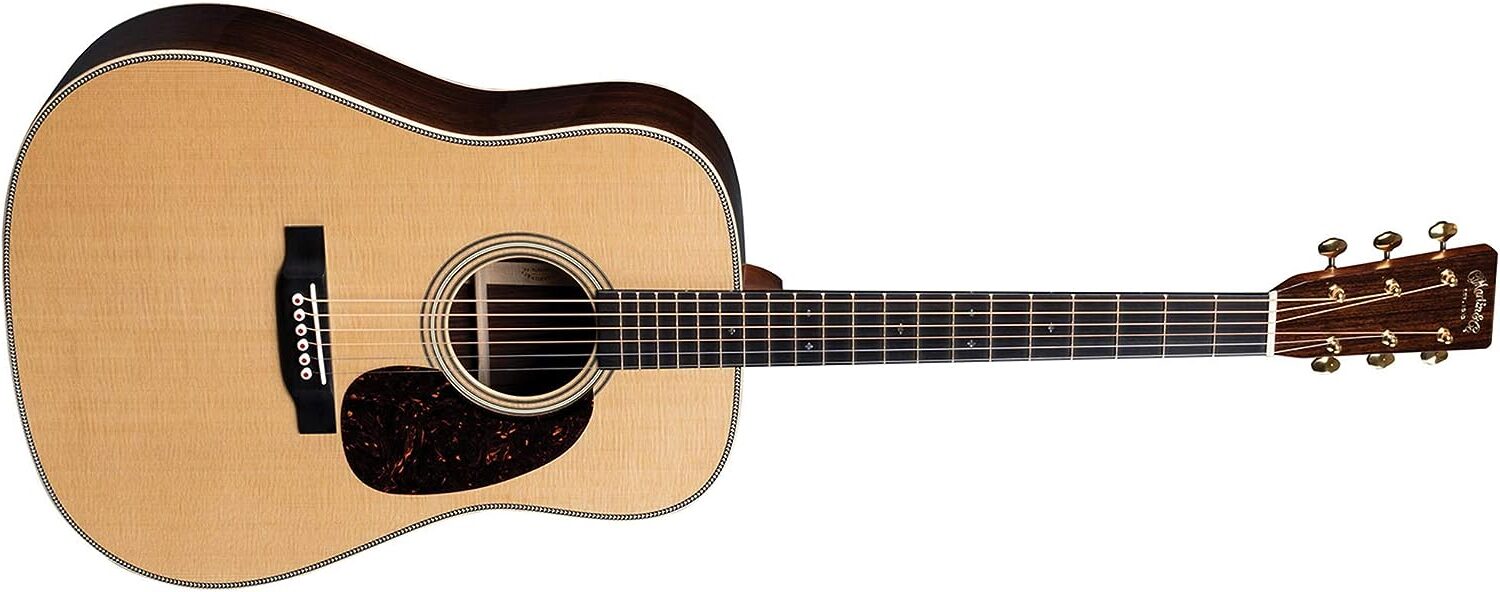
The Martin D-28 Modern Deluxe is a standout among acoustic guitars in the musical instrument scene.
It boasts a beautiful Sitka spruce top and East Indian Rosewood body, which not only add to its aesthetic appeal but also contribute to its robust and resonant sound.
Complementing the body is a mahogany neck and an ebony fretboard, truly reinforcing the deluxe quality of this piece.
Being a right-hand orientation guitar with six strings, it caters to a majority of musicians.
Presented in a natural color, it retains simplicity but doesn’t compromise on style, true to the Martin brand’s aesthetics.
Materials such as ebony, spruce, maple, mahogany and rosewoods have been generously utilized in the fabrication of this guitar, which highlights its premium character.
The product dimensions measure at 3″L x 3″W x 3″H, making it very convenient to handle and carry around.
In a nutshell, this guitar signifies the art of classic craftsmanship, while delivering a redefined musical experience.
- My Review
When one first picks up the Martin D-28 Modern Deluxe, it is easy to be immediately taken by its immaculate design and construction.
In their hands, they will find a guitar that is thoughtfully crafted with a Sitka spruce top, East Indian rosewood back and sides, and a mahogany neck, accented with an ebony fretboard.
The use of these tonewoods gives this guitar a signature sound that is rich and resonant.
With the ebony fretboard, not only does the guitar have a premium touch, but it also adds to the
clarity and sustain of its acoustic properties.
The construction of this guitar extends the natural, seamless blend of high-grade materials and innovative design — an astounding work of art.
The first few plucks of this instrument bring to light just how much depth and warmth is held in its chambers, thus, giving you an unforgettable experience.
I’m pleasantly surprised by the natural resonance and projection, which can be likened to that of a grand piano.
However, the experience didn’t come without a hiccup or two – there was a minor issue of a rattling noise at the neck joint that persisted in the early stages of use.
Fortunately, that’s a thing of the past as the problem seemed to have worked itself out with continuous play, which I attribute to the quality materials and the superior craftsmanship of Martin.
One can’t overlook the decision to have an LR Baggs Anthem installed, which is a rewarding add-on once you hear the beautiful harmony it creates when amplified.
Therefore, whether you’re recording or performing live, you’re assured of a consistent representation of the guitar’s pure acoustic sound.
Having this hand-crafted piece in your hands is likely to leave you in utter disbelief of its grandeur.
From the top-notch design to its unmistakable sound, investing in the Martin D-28 Modern Deluxe is a decision you’re not likely to regret.
It leaves an enduring impression that stands the test of time.
- Pros:
- Excellent sound quality.
- Instrument opens up over time.
- Reliable and robust construction.
- Cons:
- Initial issues with rattling noise.
My final verdict is that the Martin D-28 Modern Deluxe is an exceptional guitar.
The stellar combination of Sitka spruce top, East Indian rosewood back and sides, and mahogany neck ensures a superior tone and playing experience.
The exquisite Ebony fretboard not only adds to the guitar’s aesthetic appeal but also contributes to its high-quality sound.
If you are a right-handed player seeking a 6-string acoustic guitar with an attractive natural finish, this Martin model is definitely worth considering.
Considering the overall build and the brand reputation, the Martin D-28 Modern Deluxe undoubtedly offers great value for money.
Larrivee L-09 Acoustic Guitar
Dynamic projection, high-quality materials in Larrivee Acoustic Guitar.
This acoustic guitar comes with a sitka spruce top and Indian rosewood back sides, giving it a natural look. It offers dynamic Larrivee projection and utilizes an ebony fingerboard. Crafted for right-handed players, it features 6 strings and blends rosewood, ebony wood, and spruce materials.
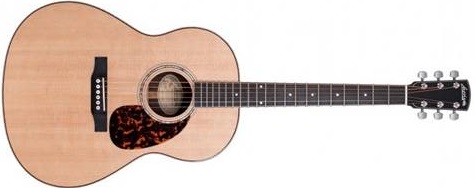
The Larrivee L-09 is a high-quality acoustic guitar, boasting a pure natural finish.
Made up of a variety of top-class materials, it employs Sitka spruce for the body and rosewood for both the back and the sides, enhancing the guitar’s resonance and durability.
The fingerboard itself is made of ebony wood, a well-chosen material for its fine texture and rich color.
It’s designed for right-hand orientation, ensuring a comfortable grip for most players.
A noteworthy feature is its 6-string configuration, which offers a wide range of tonal possibilities.
It’s the creation of renowned brand Larrivee, known for its meticulous craftsmanship in guitar-making.
One distinctive feature of the Larrivee L-09 is its dynamic projection, which helps deliver a bold, robust sound.
- My Review
Immediately upon laying eyes on the Larrivee L-09 Acoustic Guitar, the natural tone and classic design grabbed my attention.
The guitar rings true with not just the visual appeal but also with the standout Sitka Spruce top that gives it a rich and balanced sound.
The back and sides, made of Indian Rosewood, complement the Spruce top to create a compelling projection of sound, a true signature of the Larrivee line-up.
Playing this guitar, I found the ebony fingerboard comfortable, and the design ergonomic to my hand orientation, which is right-handed.
Furthermore, as a natural finish guitar, the color of the wood comes through beautifully, providing this instrument with an air of sophistication and genuine craftsmanship.
I cannot leave out the fact that this guitar is a 6-string acoustic, a feature that aligns it with many of the traditional guitars out there, making it accessible and familiar to pick up and play for any guitarist, whether beginner or professional.
The strings resonated cleanly, and the guitar’s body amplified the sound in a pleasant and adequate way.
When I strummed, I could feel the guitar responding, vibrating with life and the tonal characteristics of its construction materials.
In playing, I noticed the dynamic projection that the brand boasts of.
It was evident that this feature proved worthy, peaking the clarity without losing the warmth in playing.
Simply put, the balance between the treble and bass is impressive, creating an optimum sound experience.
Moving on to the fretboard, made of ebony wood, offered a comfortable place for my fingers to land.
The fretboard reacts quickly to movements, a feature that is key for guitarists who like fast play.
The smooth transition between chords and notes made me appreciate the detail put into this aspect of the guitar.
The fit and finish are top-notch, with everything from the binding to the inlays speaking volumes about the quality and consideration Larrivee pours into their creations.
Reflecting on my time with this guitar, I feel that it has a lot to offer in terms of sound quality, aesthetic appeal, and overall craftsmanship.
I must admit, this Larrivee L-09 is a true masterpiece in the realm of acoustic guitars.
- Pros:
- Employs Sitka spruce for the body.
- Dynamic projection.
- Indian Rosewood back and sides.
- Cons:
- No significant negatives were found.
My final verdict is that the Larrivee L-09 Acoustic Guitar is a phenomenal choice for any aspiring or professional guitarist.
The quality of the materials used, such as the Rosewood, Ebony and Spruce Wood, ensures longevity and impressive acoustic performance.
With its Natural color, it retains a classic aesthetic, further complemented by the Easily-Playable Ebony Fingerboard.
The dynamic projection of Larrivee brands is evident in this model, providing you a distinct, rich sound.
The Larrivee L-09 Acoustic Guitar offers superior quality, remarkable performance and is a real aesthetic charmer. A worthy investment indeed!
Guild F-55 Maple Acoustic Guitar
Guild Jumbo Guitar with Maple body and Spruce Top.
This acoustic guitar features a beautiful Antique Burst finish with a right-hand orientation and six strings. It boasts a spruce top and maple back sides along with a mahogany/walnut neck and an ebony fingerboard. Created by Guild, the guitar is composed mostly of Maple, offering durability and a rich tone.
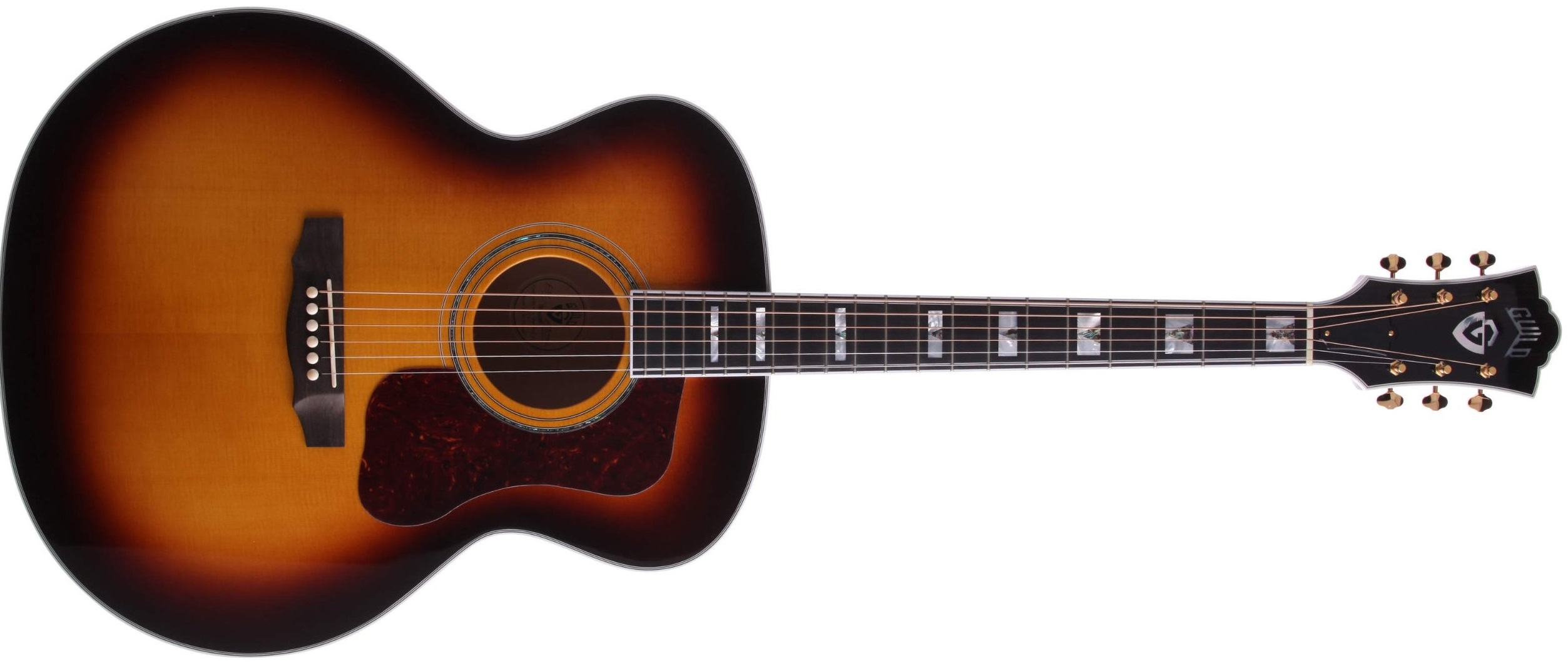
Our subject is a beautifully constructed Guild F-55 Maple jumbo acoustic guitar sporting an antiquated burst design.
One obvious aspect of this guitar is its 6-string configuration aligned with vibrantly toned Spruce wood at the top.
Ebony has been employed to construct the fingerboard adding to the aesthetic allure of this antique burst design.
The use of mixed materials like Mahogany and Walnut in the neck of the guitar grants it a unique look and tone.
The back and sides showcase a splendid maple finish, emphasizing its fine craftsmanship.
The guitar is marked with the famous Guild brand, adding a quality reassurance for the product.
The guitar’s body sporting an antique burst color is made of high quality Maple wood.
Its back too features durable Maple, catering to its robust build and durability.
The neck, like the body and back, is also made of Maple maintaining the guitar’s elegant consistency.
The fretboard is crafted out of Maple, rendering a smooth touch and lavish look.
The design of the guitar is intended for right-handed players, with the hand orientation designed specifically to suit them.
As per standard, the guitar also comprises six strings lending to its classic acoustics.
A classic Guild jumbo, embodying the true spirit of classic jumbo acoustics.
- My Review
Upon first glance, the Guild F-55 Maple, Jumbo Acoustic Guitar entices with its refined antique burst color.
Almost as if telling a story, the charm of the vintage hue takes one back to an era when craftsmanship was an intimate affair, and attention to detail was everything.
Handcrafted with spruce wood at the top, the instrument exudes an authentic feel.
Coupled with a high-quality maple and wood body, this material choice not only makes the guitar aesthetically pleasing, but also enhances the sound produced.
Taking a closer look, one cannot help but appreciate the ebony fingerboard, a feature that very well complements the antique burst finish.
Moreover, the choice to use maple wood for the back sides denotes a high value on durability without sacrificing the overall weight of the guitar.
A comfortable grip is assured thanks to the right-hand orientation, making it an asset for individuals with a right-hand preference.
Where the Guild F-55 truly shines, however, is in its magnificent sound.
Equipped with six strings, it manages to create profound melodies with the slightest pluck, a testament to its build quality and sound engineering.
Interestingly, even as your fingers wander across the fingerboard, the mahogany/walnut neck provides excellent playability.
The merging notes come alive, floating smoothly in the air, thanks to the careful selection and combination of spruce, walnut, and maple wood.
Noticeably, the guitar’s sound does not falter even after continuous playing, bringing on the nostalgia of yesteryears rock ‘n roll and blues melodies.
Regrettably, the guitar might not be as welcoming to left-handed users due to its right-hand orientation design.
Despite this fine line in the sand, the Guild F-55 Maple Acoustic Guitar delivers an extraordinary acoustic experience.
So, whether it’s for a professional performance or a jam session under the starry sky, each strum makes a mark.
Ultimately, the Guild F-55 is a musical instrument that flawlessly marries form, function, and timelessness to birth magnificent melodies.
The guitar, quite frankly, is not just a guitar.
It’s a heritage that embodies the ancient wisdom of music, made tangible through timeless craftsmanship.
Based on the provided description and specifications of the guitar, but no given reviews, another way of creating pros and cons for the Guild F-55 Maple, Jumbo Acoustic Guitar – Antique Burst might look like this:- Pros:
- Classic Guild Jumbo design.
- Spruce Top with Maple Back Sides.
- Ebony Fingerboard for smooth play.
- Cons:
- Potentially heavy due to size.
My final verdict is that the Guild F-55 Maple, Jumbo Acoustic Guitar – Antique Burst will not disappoint.
This guitar, with its Maple Back and Sides and Spruce Top, produces truly rich and distinguished sound.
The combination of Mahogany/Walnut neck and Ebony Fingerboard gives it an unparalleled feel and playability.
If you are a right-handed player, this guitar with 6-strings will cater to your needs.
It is a top-notch instrument worthy of the Guild branding.
Gretsch Guitars G5022C Rancher Falcon Cutaway Acoustic-Electric Guitar
Jumbo tone guitar with exceptional amplified performance.
This full-bodied jumbo guitar features an impressive gloss white finish with sparkling golden details and advanced onboard electronics for superior amplified sound. The G5022C Rancher Falcon Cutaway boasts lavish elements, including a solid spruce top, laminated maple back and sides, and a mahogany neck with a 21-fret fingerboard. The Fishman Sonicore pickup and the Isys+ preamp system contribute to its outstanding performance, ensuring high-quality sound production.
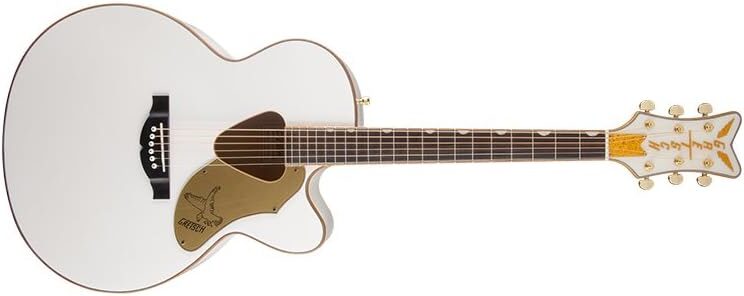
The Gretsch Guitars G5022C Rancher Falcon Acoustic-Electric Guitar sports a striking aesthetic with its white body accentuated with gold sparkle details.
It boasts a 17-inch jumbo cutaway model which amplifies its sound quality.
Made with solid spruce for the top and an appealing laminated maple for the back and sides, this guitar is not just sound, but a sight to behold.
Moreover, the body is coated with a glossy polyester finish which gives it a sleek and shiny look.
The instrument’s neck is crafted from premium mahogany that beautifully complements its rosewood fingerboard, adorned with gold sparkle binding and B/W/B/W purfling.
Adding more to its features, it comes with 21 vintage styled frets and nickel strings which assist in producing a clear and full-bodied tone.
Notably, it’s a right-hand orientation guitar equipped with GR2714024505 pickup configuration.
On top of these, the Gretsch Guitars G5022C is furnished with a Fishman Sonicore undersaddle pickup and ISYS+ preamp system enhancing its amplified performance.
These systems offer accessible controls for volume, tone, phase and even include an onboard tuner and battery life indicator which makes it a user-friendly guitar.
- My Review
From my personal experience with the Gretsch Guitars G5022C Rancher Falcon Cutaway Acoustic-Electric Guitar, it’s fair to say that it stands out for its unique aesthetic appeal.
Laden with sparkling gilded appointments and finished in gloss white, this guitar is a statement maker.
The gold-sparkle binding on various parts including the top, back, soundhole, fingerboard and even the headstock further enhances the overall look and feel of this beautiful musical instrument.
Now, let’s talk about its playing quality.
With a jumbo cutaway body and a solid spruce top, accompanied by trimmings of laminated maple on the back and sides, the guitar creates a rich, full-bodied jumbo tone.
When it comes to ease of playing, the guitar is outstanding.
The strings can be effortlessly pushed down thanks to the fine mahogany neck and the fingerboard of rosewood with Gold Sparkle Binding and B/W/B/W Purfling.
I must mention the pickup and preamp system, which I believe elevate this guitar to a different realm.
Onboard electronics from Fishman Sonicore enable better amplified performance, coupled with volume, tone and phase controls, onboard tuner and battery life indicator gives you complete control over your sound.
Diving into the playability and sound of this guitar, both acoustically and plugged in, it’s quite obvious the guitar produces a brighter tone.
It offers a perfect equilibrium between playability and tone, suited for various music styles given its versatile tonal dynamics.
That being said, there were a few issues that I encountered.
Initial setup of the guitar requires some special attention.
Specifically, the bridge was a bit low causing the high E to touch the fretboard.
Another notable aspect was the string quality.
The strings seemed to buzz and thus may require a replacement to ensure a better sound output.
However, overall, despite these minor setbacks, I found the Gretsch Guitars G5022C Rancher Falcon Cutaway Acoustic-Electric Guitar to be a good quality guitar both in terms of sound and aesthetics.
Aesthetically pleasing, highly playable and affordable, this guitar is absolutely a viable option for both budding musicians and experienced guitarists.
- Pros:
- Excellent sound and tone.
- Beautiful and unique design.
- Smooth and easy playability.
- Cons:
- Potential issues with humidity.
- Possible structural defects on arrival.
My final verdict is that the Gretsch Guitars G5022C Rancher Falcon Cutaway Acoustic-Electric Guitar is a truly remarkable instrument.
This guitar doesn’t just excel in appearance – with its white gloss finish and gold-sparkle binding – but it also surpasses expectations in sound and performance.
The Fishman Sonicore undersaddle pickup and the Isys+ preamp system work seamlessly to provide an unparalleled amplified tone.
Whether you’re a professional guitarist or a beginner, the combination of classic Rancher style with modern onboard electronics make this guitar well worth considering.
Highly recommended for anyone seeking excellent build, sheer elegance and superior sound in an acoustic-electric guitar.
Yamaha SLG200S Acoustic-Electric Guitar
Natural acoustic tone, convenient for quiet practice
This guitar is ideal for travel, practicing or on stage due its near-silent performance and Yamaha’s distinctive SRT-Powered pickup system. Sporting a Translucent Black Finish, Steel Strings and a portable rosewood and maple body, it offers natural acoustic tone and enhanced studio-quality effects. Complete with a Tobacco Sunburst color and packed in a hard gig bag, its unique look and fixed bridge system make it a standout choice.
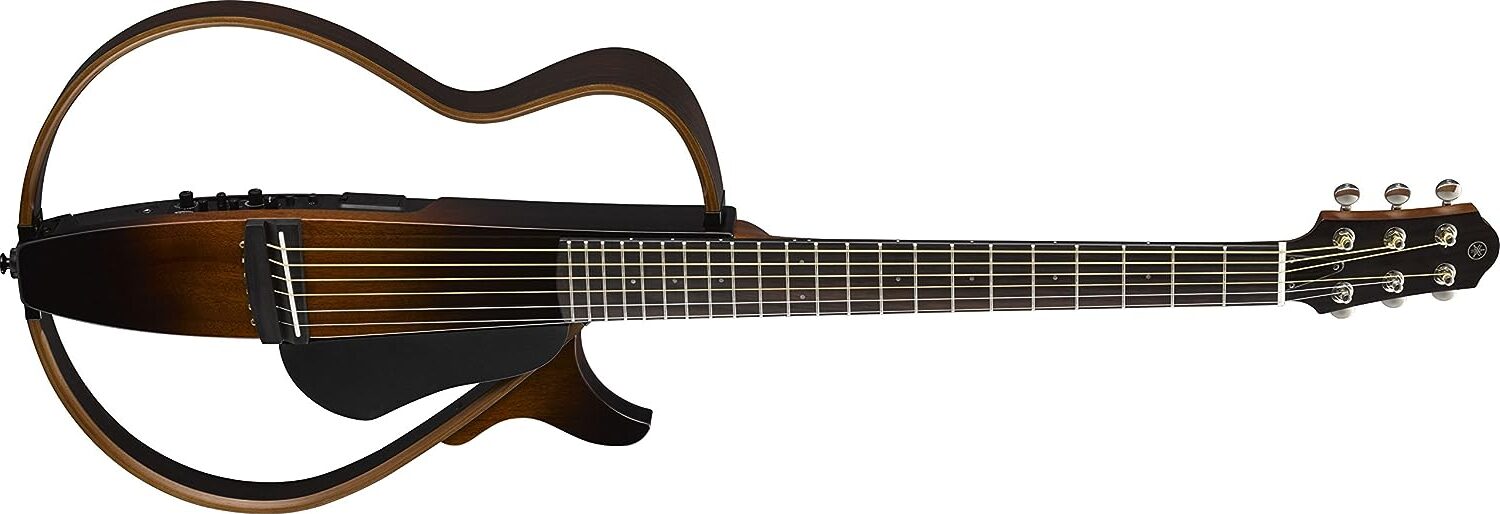
If you’re seeking an instrument suitable for different environments, be it practicing in silence, hitting the road or performing on stage, then the Yamaha SLG200S TBS is your go-to choice.
Finished in a sleek Tobacco Sunburst color, it offers a visually striking aesthetic that captures sight at a glance.
Speaking of materials, it boasts a body and back made from Mahogany, while Maple wood and Rosewood are used for its top part.
Moreover, not only does it have a Piezoelectric guitar pickup configuration, but Yamaha’s proprietary SRT-Powered pickup system is incorporated too, which achieves an impressively authentic acoustic tone whether through headphones or line-out.
Studio-grade effects are built right onto this creation, letting you enhance your performance with ease, complemented by a line-in function for effortless jamming.
As a unique touch, this full-size guitar has a collapsible body framed with rosewood and maple, allowing you to play your songs wherever and whenever the inspiration sparks.
It’s a right-hand orientation guitar that comes with Alloy Steel strings and a fixed guitar bridge system, rounding out its robust build.
Last but not least, it comes with a hard gig bag, ensuring that you can store and transport it safely without worry.
The Yamaha SLG200S is something of a silent guitar, allowing for a near-silent operation that makes practicing in discretion a breeze.
- My Review
I must begin by expressing my absolute admiration for the visual aesthetics of the Yamaha SLG200S TBS Steel String Silent Guitar.
Simply put, it exudes a modern artistic charm that effortlessly captures attention and immediately elevates the mood of any room it’s placed in.
As a player, the first thing I noted was the hit of subtle beveling on the interior of the body – it’s an element of detail that really demonstrates Yamaha’s commitment to crafting a user-friendly and premium instrument.
The ebony fingerboard is particularly noteworthy for its impeccable smoothness, providing a truly covetable playing experience.
But let’s delve deeper into the heart of this instrument – its sound profile.
When playing this guitar with the pickup, one is immediately met with a noticeably full and rich sound.
A significant advancement from Yamaha is their SRT-Powered pickup system, which indeed delivers an astonishingly natural acoustic tone through headphones.
Furthermore, a feature I admire is the studio-quality on-board effects that bring your playing closer to perfection.
There’s a certain versatility offered, allowing you to craft a harmonic profile that fits your style and mood perfectly, not to mention its line-in functionality that facilitates easy jamming sessions with peers.
The guitar handled alternate tunings with ease and the onboard chromatic tuner was a delight to use.
Moreover, considering it is branded as a ‘silent guitar’, I was surprised and pleased at how near-silent it was – making discrete practice an absolute breeze.
However, I must note that the bass overpowers the treble in certain settings, which may require careful adjustments on the part of the player to balance it out.
This guitar requires headphones for a normal playing volume, so if you’re after something you can just pick up and play with a naturally loud sound, it may not fully meet your expectations.
Nonetheless, as the final piece to the puzzle, this guitar comes with a hard gig bag that is handy for travel and protection.
All these features combined make the guitar an exceptional companion for the travelling musician, or anyone who seeks a unique, compact, and highly functional instrument tailored for practice, performance and fun.
However, remember to replace the strings when you first receive the guitar to ensure the sound produced is your desired quality.
Despite a few drawbacks, the Yamaha SLG200S more than stands its ground as a highly versatile and visually stunning instrument that brings you as close as possible to a true acoustic guitar experience.
- Pros:
- Superb sound quality.
- Stunning design and finish.
- Excellent for silent practice.
- Cons:
- Possible high string action.
- Subpar electronics quality.
My final verdict is that the Yamaha SLG200S TBS Steel String Silent Guitar, with its unique features, is an exceptional musical instrument worth investing in.
Its near-silent performance and SRT-Powered pickup system sets it apart, making it perfect for practice, travel or stage use.
Using a blend of Maple Wood and Mahogany, the construction ensures great durability.
If you value sound quality, versatility and convenience, this might be the perfect fit for you.
Fender American Acoustasonic Telecaster Acoustic Electric Guitar
Revolutionary acoustic-electric hybrid with versatile tones
This acclaimed guitar blends innovative shape-shifting technology for distinct acoustic and electric tones with superior craftsmanship from mahogany and spruce wood. Its design features an integrated forearm and back contour and comes with a convenient gig bag. Equipped with a revolutionary Fender and Fishman-designed Acoustic Engine, it delivers an unprecedented range of sonic expressions from the studio to the stage.

This is a description of the Fender American Acoustasonic Telecaster, an acoustic-electric hybrid guitar that comes in a sunburst color.
What stands out about this instrument is its innovative acoustic shape-shifting and the diverse range of electric tones it can produce.
The guitar features five unique voice pairs that bring together the best of both acoustic and electric play for a decidedly curated experience.
It also offers an integrated forearm and back contour and a Mahogany Modern “Deep C” neck, which adds to its ergonomic design and playing comfort.
As per the detailed specs, the guitar is produced by the famous brand Fender and has a spruce wood top with mahogany body and back, contributing to its exceptional sound quality.
The neck is also made of mahogany while the fingerboard is made of ebony wood.
The pickup configuration of this guitar is remarkable with a mix of N4 Magnetic; Fishman Under-Saddle Transducer; Fishman Acoustasonic Enhancer.
The strings are made from phosphor bronze, and the guitar is designed for right-handed players.
The Fender American Acoustasonic Telecaster is a fantastic blend of traditional and forward-looking design, allowing players to explore a wide spectrum of acoustic and electric sound possibilities.
- My Review
First and foremost, as someone who truly values craftsmanship and attention to detail, I must admit that Fender’s American Acoustasonic Telecaster is visually striking.
The sunburst shade adorning its body, made out of rich mahogany and spruce wood, imparts a feeling of vintage charm.
Having also played around with the guitar’s various functions, I noticed the Acoustasonic’s shape-shifting acoustic and electric tones to be quite remarkable.
This, combined with its collection of 5 distinct voice pairs, makes this masterpiece versatile and capable of creating a plethora of sounds and tones, thereby inspiring a whole new world of sonic exploration.
Moreover, the Acoustasonic’s unique design features, including its integrated forearm and back contour and a comfortable modern “Deep C” mahogany neck, truly enhance the playing experience.
Speaking from an acoustic perspective, the Acoustasonic Telecaster resonates sound that is pleasing to the ears yet doesn’t overpower the room, making it a fine choice for practice sessions at home.
On transitioning to an electric mode, the guitar leaps into a different sonic universe altogether, not missing a beat with its strong and robust output.
There is no denying that this guitar has been crafted with gigging musicians in mind and, to that end, it doesn’t disappoint.
While the overall performance is largely commendable, I did come across a few snags that could potentially frustrate some users.
One, in particular, is the tendency for the high E string to pop out of the nut, a minor setback that could potentially be corrected with a string guide.
Another thing that piqued my interest was the guitar’s Fishman Under-Saddle Transducer and Acoustasonic Enhancer.
While they indeed produce decent tones, I couldn’t help but feel that they seemed to lack the true essence of what the respective guitars they were trying to mimic would sound like.
And finally, on a similar note, the technology that allows for the guitar’s acoustic shaping comes across as a bit gimmicky rather than genuinely innovative, a sentiment that rings even truer when considering the guitar’s somewhat lofty price point.
In the face of these drawbacks though, what cannot be denied is that the American Acoustasonic Telecaster indeed has the potential to be a great addition for the modern guitarist who craves for versatility and a blend of electric and acoustic tones all in one sleek package.
- Pros:
- Versatile with multiple tones.
- Lightweight and comfortable to play.
- Good for practice and gigs.
- Cons:
- Possible issues with string popping out.
- Some report finish quality issues.
- Major buzz problems for some.
My final verdict is that the Fender American Acoustasonic Telecaster Acoustic Electric Guitar is a fantastic and versatile instrument.
Its innovative acoustic shape-shifting and electric tones offer a range of distinct voices which are impressive.
The high-quality materials and exquisite craftsmanship showcase Fender’s dedication to offering a top-notch musical device.
Whether you are in the studio or on stage, this guitar will unleash your creativity and amplify your performance.
It is a worthy investment for any serious or aspiring musician.
Guild F-250CE Deluxe Acoustic-Electric Guitar
Loud, crisp voice with sustained tone
This jumbo guitar boasts a solid spruce top, flamed maple back and sides for a loud, crisp voice with sustained tone. It features a mother-of-pearl rosette, Guild Peak headstock logo, and pau ferro fingerboard and bridge. The F-250CE Deluxe comes with a soft cutaway for easy fret access and a Fishman Sonitone pickup for easy plug and play.
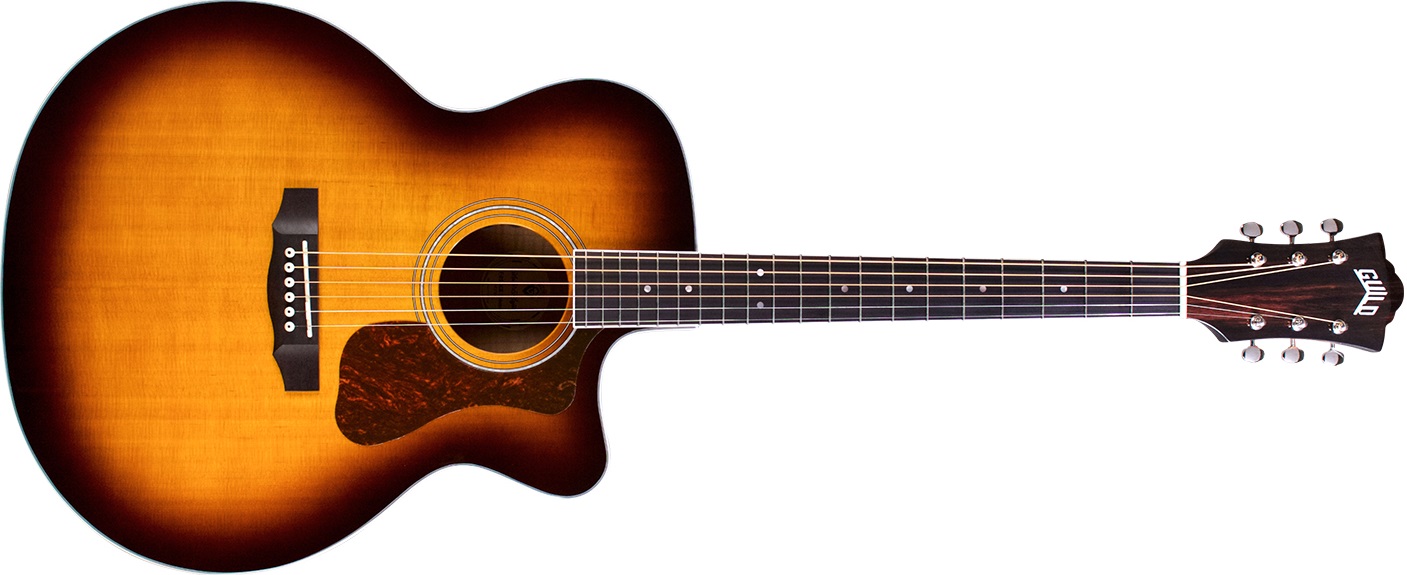
This acoustic-electric guitar produced by Guild is known as F-250CE Deluxe and flaunts an attractive Antique Burst finish.
Its 6-string configuration gives musicians a broad spectrum of tune possibilities.
With a Solid Spruce top, it ensures robust and vibrant sounds.
Enhanced with onboard electronics, it provides the flexibility to easily connect to an amp or recording output.
A high-quality Pau Ferrowood is employed in the making of the fingerboard, known for its firmness and smoothness.
The guitar’s neck material is Mahogany, providing it superior stability and increased resonance.
The brand behind this guitar is Guild and it sports an Antique Burst color scheme.
The top and back parts of this guitar are made from Maple, giving it both strength and a wonderful tonal quality.
The body of the guitar is made with Spruce, adding to its acoustic characteristics.
It’s built with a Piezoelectric pickup configuration, enhancing its ability to convert vibrations to electrical signals seamlessly.
The strings are made with Phosphor Bronze material, which is known for its bright and well-rounded tone.
Designed for right-handed players, this guitar ensures the utmost comfort in playing.
The F-250CE Deluxe is not just a guitar, it’s an instrument that has been thoughtfully designed with superior materials to bring out loud, crisp sounds with a lasting tone.
Its unique features like mother-of-pearl rosette, Guild Peak headstock logo, soft cutaway for higher fret access, and a Fishman Sonitone pickup with easy volume and tone controls will truly enhance your musical journey.
- My Review
Upon first impression, the Guild F-250CE Deluxe struck me as extraordinary, not just visually but in sound quality as well.
Clearly, meticulous craftsmanship has gone into its design as the antique burst resonates with an air of nostalgia and elegance.
With a solid spruce top and the stunning arched flamed maple back along with flamed maple sides, this guitar is a feast for the eyes.
Sustained tone and a loud, crisp voice are evident features from the combination of the top-notch tonewoods used.
Furthermore, the guitar does an impressive job in enhancing my sonic range with on-board electronics, and the Fishman Sonitone pickup certainly offers ample control over the outputs.
Playing the guitar is a dream, largely due to the Pau Ferro fingerboard and a comfort-ready mahogany neck.
Although I did encounter a slight hiccup with the action being high, it did not pose a major issue and was remedied with some minor adjustments.
Also, I was a tad disappointed with the quality of the guitar tuners as they appeared quite marginal, however, this issue will be resolved with a simple upgrade.
The instrument tunes up effortlessly, with the sound being a delightful ever-resonant hum throughout my playtime.
While the plastic bridge pins may need a substitution, the guitar’s saddle and nuts are immaculately solid.
In terms of performance, this has been a joy to play; the notes and chords ring out with an air of clarity and warmth that you’d associate with a higher-end instrument, each strum vibrates harmoniously.
On my quest for a good gigging guitar, I believe I have found a reliable companion in the F-250CE Deluxe.
It goes without saying that the Guild F-250CE is considerably impressive for its price range, thus it would be an asset for a guitarist of any level.
However, an area where improvements could be made pertain to the guitar’s packaging as it impacts the product’s final condition upon arrival.
Despite a few minor initial setbacks, the Guild F-250CE Deluxe not only lives up to its name but also raises the bar in what we should expect from guitars in this price range.
- Pros:
- Excellent design and build quality.
- Clear, balanced sound projection.
- Offers good playability.
- Cons:
- Some components quality questionable.
My final verdict is that the Guild F-250CE Deluxe – Antique Burst is an exceptional choice for serious musicians and enthusiasts alike.
The solid spruce top and flamed maple back and sides contribute to its sustained, rich sound, making it stand out in the crowded acoustic-electric market.
Its Fishman Sonitone pickup provides excellent versatility and control, facilitating live performances and recording sessions.
The pau ferro fingerboard and mahogany neck are not only aesthetically pleasing but also comfortable for players of all levels.
This guitar presents an impressive combination of style, playability, and sonic character.
Takamine EF341SC Pro Series Dreadnought Acoustic-Electric Guitar
Versatile, high-quality guitar with outstanding acoustic tone.
This handcrafted dreadnought guitar boasts a solid cedar top complemented by maple back and sides which reflect tone perfectly. The instrument offers a mahogany neck and a rosewood fingerboard, assembled via a sturdy dovetail joint. Featuring an industry-praised Taka mine’s palathetic pickup and CT4B preamp, the guitar delivers natural acoustic tones with high sound pressure levels.
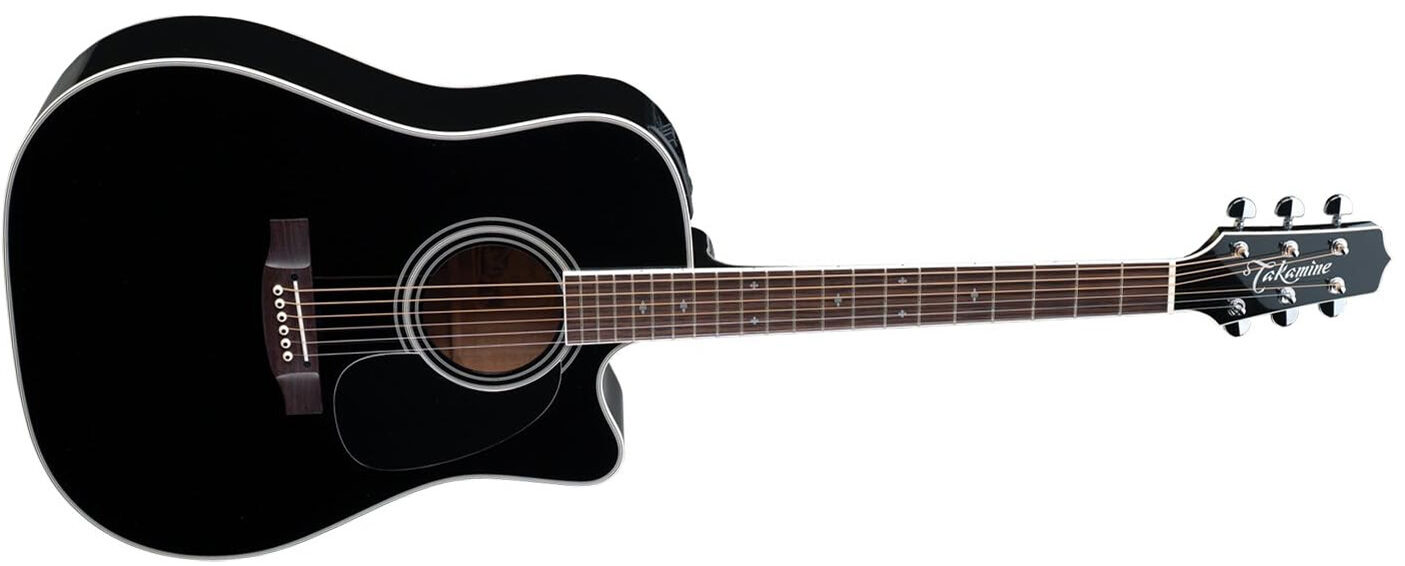
In the hands of serious musicians for decades, this Takamine EF341SC Pro Series Dreadnought Acoustic Electric Guitar emphasizes quality and precision.
One remarkable feature of this instrument is its solid cedar top, perfect for delivering soft, melodious tunes and robust, power chords.
This guitar also boasts a maple back and sides, acting as an excellent amplifier of the sound produced by the soundboard, and coated in a lustrous black finish that steals the show under any lighting on stage.
Contributing to the durability of this product is the guitar’s neck, which consists of genuine mahogany wood that attaches to the body of the guitar through a sturdy dovetail joint.
Equipped with a Takamine’s palathetic pickup, this acoustic electric guitar generates a true and natural sound, earning its place as a favorite amongst professionals in the music industry.
The model also includes the CT4B preamp, well-recognized amongst other models for providing a clear, authentically acoustic tone, even at high sound pressure levels.
Fabricated by skilled craftsmen in a facility that takes pride in producing high-quality instruments, this Takamine guitar offers both enduring quality and unrivaled performance.
- My Review
Unboxing the Takamine EF341SC Pro Series Dreadnought Acoustic Electric Guitar, the first impression was that of an exquisite instrument.
The glossy black finish is visually stunning and incredibly professional, making the guitar not only sound amazing, but also look incredible under stage lights.
It’s further complemented by the maple back and sides which are indeed a perfect reflector for the tone generated by the soundboard.
This is an instrument that truly shines in its performance ability.
Equipped with a solid cedar top, this guitar offers a versatility that impresses me.
Whether I want to play sweet mellow passages or power chords, its response is equally commendable, making it a versatile choice regardless of genre or playing style.
Moving on to the neck, it is made of high-quality mahogany and rosewood fingerboard, a combination that offers comfortable playability.
The CT4B II Electronics integrated into this guitar further highlights its superior quality.
This acoustic/electric pickup is accurately and naturally sounding, providing warm and natural tone at high sound pressure levels.
In my hand, it feels like it’s been designed with a deep understanding of the needs of different types of guitarists – from the beginner to the more accomplished performer.
Examining the guitar closer, I noticed the dovetail joint, which brings the mahogany neck to the body, is traditional but incredibly strong.
I should also add that the guitar requires some minor adjustments upon arrival to achieve your desired set up.
But once these details are sorted, the result is a guitar that is a joy to play.
My notes glide effortlessly on the fingerboard, and the resonance of each note is rich and deep.
Indeed, with the Takamine EF341SC, the quality of the sound is superb.
Taking all of this into consideration, you’ll find that the price tag is justified.
Whether you’re a performer who is frequently on stage or someone who plays as a hobby, I’m confident it would prove worth the investment.
After all, it’s not just a guitar but also a statement of style, performance, and craftsmanship.
- Pros:
- Excellent for live performances.
- Incredible sound and tone.
- High-quality, durable construction.
- Cons:
- Black finish shows dust/scratches.
- Possibly overhyped.
My final verdict is that the Takamine EF341SC Pro Series Dreadnought Acoustic Electric Guitar is an excellent instrument for professionals and serious musicians.
Its solid cedar top and maple back and sides offer incredible sound versatility, catering to a variety of music genres.
The gloss black finish and dovetail joint not only add to its sleek looks but ensure its robustness and longevity.
The Takamine’s palathetic pickup and the CT4B preamp are noteworthy features for delivering warm, natural tones at high pressure levels.
Its quality, sound, and construction rightfully establish it as a good value for money investment in the long run.
Luna VISTA EAGLE Acoustic-Electric Guitar
Innovative design with unique, vibrant wood veneers.
Crafted with an assortment of tropical wood types, this acoustic/electric guitar boasts an extensive feature set that includes a grand auditorium body, an ebony fretboard and bridge, and a B-Band T55 preamp/tuner. The unique Vista series applies innovative design to evoke majestic landscapes, encouraging expansive creativity in its users. Built with natural variations for uniqueness, this particular model features a rosewood body, a mahogany neck, and a right-hand orientation.
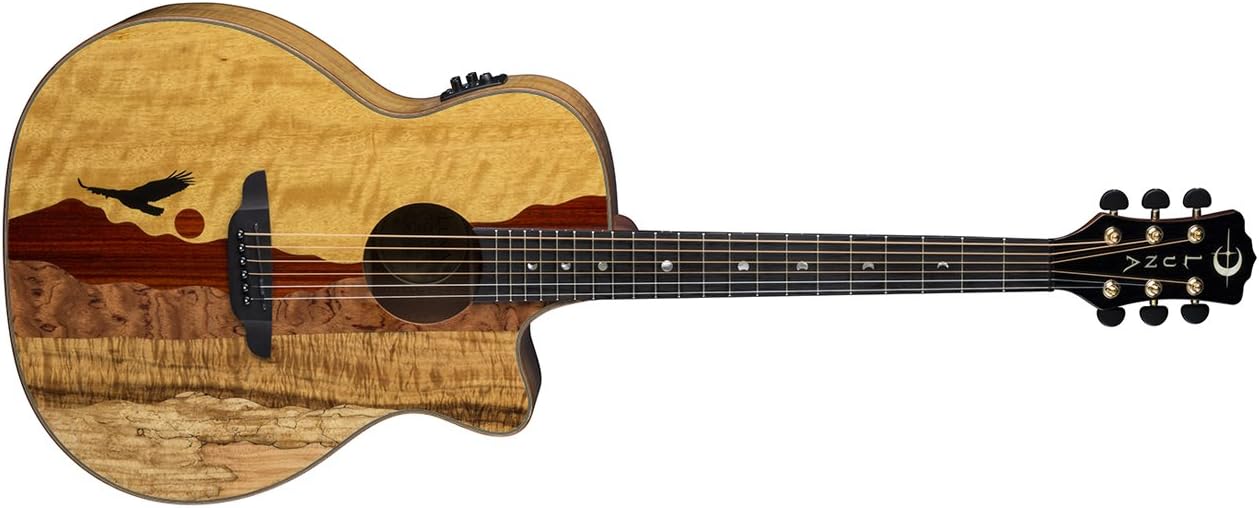
This Luna VISTAEAGLE Luna Acoustic/Electric Guitar comprises different tropical woods, bestowing it a unique aesthetic appeal.
Its body is shaped in a grand auditorium style, a design favored for its balanced tone and versatility.
The guitar’s top features a blend of exotic woods including moving, pad auk, bubinga, koa and spalt maple.
The back and sides of the instrument are crafted from koa wood, which is known for its rich, resonant sound.
A crucial part of the guitar is its ebony fretboard and bridge, which greatly contributes to the clarity of the tone.
It comes equipped with a built-in B-Band T55 preamp and tuner, allowing you to easily amplify the sound and stay in tune.
This guitar also comes with a hard-shell case for protective storage.
Apart from these, it has Rosewood as its body material and the fretboard also shares the same rosewood composition.
The back material is Koa and it is designed for right-handed players.
The neck material is made of Mahogany, and it’s part of the renowned Luna Guitars brand.
The guitar has a fixed bridge system and a scale length of 25.5, which is a common size for comfort and tone.
As a part of Luna Guitars’ innovative Vista series, this guitar reflects the inspiration of majestic landscapes, offering players a chance to explore their creativity.
The guitar’s individuality is further accentuated by the natural variations in the wood grains and color, making each model a unique piece.
- My Review
I was captivated by its exquisite design when I laid my eyes on the Luna VISTAEAGLE Luna Acoustic/Electric Guitar.
Adorned with a myriad of tropical woods such as moving, pad auk, bubinga, koa and spalt maple, the guitar epitomizes the breathtaking beauty of Mother Nature herself.
Embodiment of its grand auditorium body shape, the Luna VISTAEAGLE exudes a sense of majesty and prominence.
The guitar’s back and sides showcase the luxurious essence of koa which contributes to its distinct tonal quality.
Equally impressive is the ebony fretboard and bridge which factor in adding a robust rich resonance to the guitar’s sound.
Hexed by its enchanting aesthetics, I found myself leaping into a euphoric state upon strumming the first note.
Though slightly tinny, the acoustic sound carries a unique charm that presents a refreshing take to the familiar acoustic tone.
A notable inclusion is the B-band T55 preamp and tuner, an intuitive tool that optimizes the guitar’s electric performance.
Admittedly, the sound projection doesn’t quite justify its majestic build, as it falls slightly flatter and lacks the encompassing sound typical with grand auditorium shapes.
Notheless, this interpretation could largely be due to the blend of various woods which distinctly affects the sound density and character.
Moving on to the guitar’s playability, it’s as if Luna Guitars dedicated an immense amount of consideration while designing the guitar.
The guitar’s comfortable string action, sleek neck relief, and immaculate fretwork combined to facilitate superb playability.
Despite its less prominent bass response, the Luna VISTAEAGLE manages to deliver a surprisingly bright and crisp tone that fingerstyle players might particularly appreciate.
Considering its sublime looks and captivating charm, it may appear to many as a generously priced, predominantly ornamental piece.
However, it’s the Luna VISTAEAGLE’s ability to balance aesthetics, functionality, and sound which ultimately delivers a unique musical companion than a mere eye-candy.
Equipped with a vast spectrum of intrinsic features and a striking appearance, the Luna VISTAEAGLE is not just a guitar; it’s an invitation to explore an uncharted territory of musical creativity.
- Pros:
- Sturdy construction.
- Impressive electric sound.
- Beautiful aesthetic design.
- Cons:
- Acoustic sound can be tinny.
- Top built with veneer laminate.
- Lacks bass for Dreadnought players.
My final verdict is that the Luna VISTAEAGLE Luna Acoustic/Electric Guitar is an absolute gem.
The concert auditorium body made from rare and high-quality woods offers superb sound quality whether you’re strumming or picking.
Its stunning aesthetic, with a combination of tropical woods and beautiful design, helps it stand apart from the competition.
The inclusion of a B-Band T55 preamp/tuner and hard-shell case adds considerable value.
It’s a beautiful, quality instrument worth every penny.
Martin D-45 Natural Acoustic Guitar
Flagship Martin guitar with stunning sound and aesthetics.
This top-tier dreadnought is the flagship of Martin Standard Series with East Indian rosewood body and spruce bracing. Notable for its abalone style 45 hexagon inlays and Style 45 purfling, it’s the choice of renowned musicians like Gene Autry and Stephen Stills. The 2018 version introduces new forward shifted X bracing, open gear tuners, an aging toner top finish, and a modern high performance neck profile.
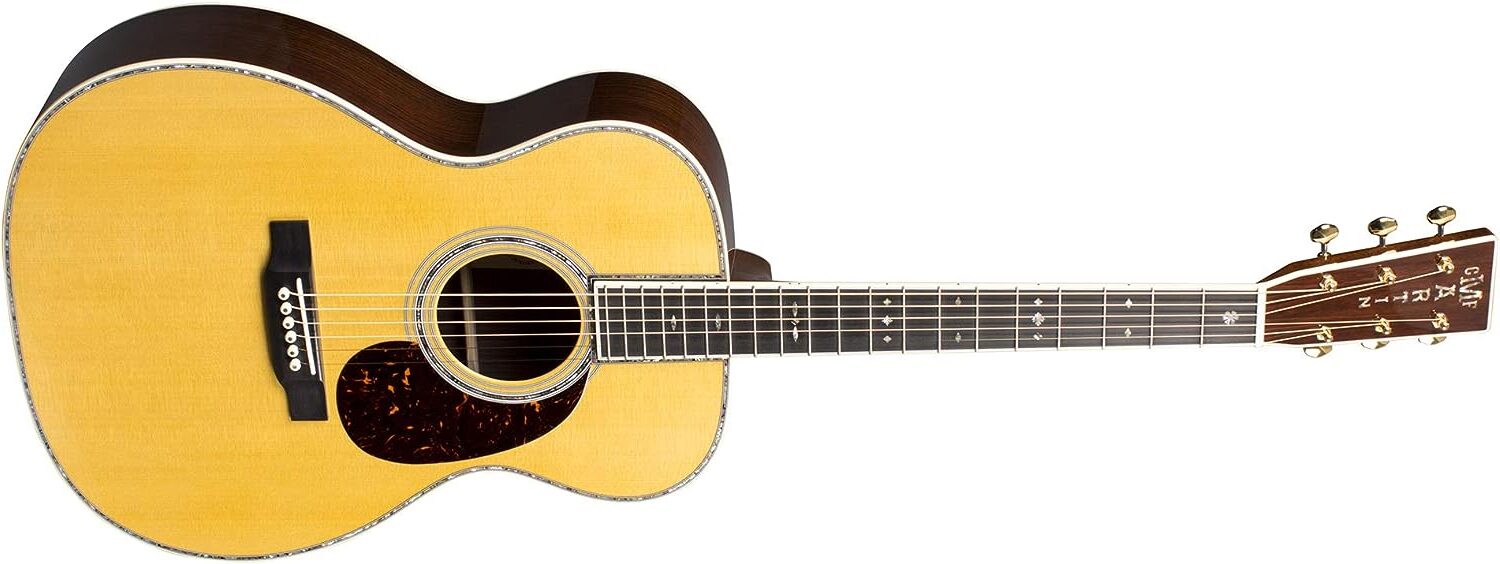
The Martin D-45 Natural is a stunning dreadnought guitar, a style mindfully conceptualized and brought to life by the brand itself.
Offering a classic, natural gloss finish, this guitar comes from the esteemed Martin Standard Series and is rightfully their crowning jewel.
Constructed with high-end East Indian rosewood for the back, sides, neck, and fretboard, the body material is also rosewood, contributing to a consistent, thorough tone.
The guitar maintains a robust resilience with spruce wood being the top material.
The Martin D-45 Natural is crafted with an astute attention to details notably the Style 45 purfling and the elegant abalone styled 45 hexagon inlays.
Known for its right-handed orientation, this guitar is equipped with a total of six strings.
Exhibiting a modern design and a convenient size, its dimensions are 47″L x 20″W x 9″H.
Additional attractive attributes include open gear tuners and a unique top finish, achieved using an ageing toner.
The high performance neck profile has been subtly crafted to stimulate ease of play.
Notably, it has been designed with a forward shifted scalloped X bracing, a structure unique to the guitar.
- My Review
The Martin D-45 Natural is an exceptional instrument showcasing the Martin brand’s impeccable craftsmanship.
I found the use of rosewood for the top, body, back, neck and fretboard material really contributes to this guitar’s rich, warm tone.
Playing this dreadnought beauty, it’s impossible not to notice its sound profile’s deep resonance and superb balance, a testament to the high-quality sitka spruce wood used for the top.
This guitar’s right-handed orientation, combined with its impressive six-string setup, offers great versatility – whether you are strumming a soft melody or picking a fast, intricate tune.
Both look and feel are critical aspects of any guitar, and the Martin D-45 Natural does not disappoint.
The natural gloss finish of the sitka spruce top gives it an appealing, timeless aesthetic, easily catching the eye.
One can’t help but appreciate the subtle elegance of the abalone style 45 hexagon inlays, which further enhance its design.
On the downside, I noticed there seemed a slight issue with default plastic strings included, but it was nothing that a swift change to my personal preference of steel couldn’t resolve.
It’s also important to take into account the durability of the guitar.
While the Martin D-45 Natural generally offers a sturdy build, I found that precautions must be taken to maintain the integrity of the guitar, like regulating humidity levels and using the proper cleaning methods to avoid damaging the natural wood finish or the strings.
Considering the strap’s glue strength, there could be improvements on that front.
Weighing all its attributes, the Martin D-45 Natural is a remarkable instrument that offers premium sound and craftsmanship.
No doubt, it’s a substantial investment, but one well worth considering if you’re seeking superior tone and the unmatched feel of a well-built dreadnought guitar from a renowned brand.
With a little maintenance and care, the Martin D-45 Natural can indeed live up to its reputation as a high performing, visually stunning instrument.
- Pros:
- Beautiful pieces of East Indian rosewood.
- Scalloped sitka spruce bracing.
- New forward shifted X bracing.
- Cons:
- Came with plastic strings.
- Possibility of cracks occurring.
- Back edge strap can fall off.
My final verdict is that the Martin D-45 Natural is an extraordinarily crafted guitar.
The authentic materials like East Indian Rosewood and Sitka Spruce make it stand out from the competition.
Not only is its appearance stunning, but it also provides an exceptional sound quality that makes it worth every penny.
The 2018 new features like the open gear tuners and modern neck profile enhance the performance of an already exceptional instrument.
Considering all factors, the Martin D-45 Natural is certainly one of the best high-end guitars on the market and is highly recommended.
Washburn Woodline Series WLO20SCE Acoustic-Electric Guitar
Elegant, affordable guitar with exceptional tone and stability.
This is a right-handed, cutaway orchestra guitar with a Sitka spruce top and rosewood back and sides, which provides a unique balance of musicality, elegance, and affordability. It has a gloss finished body, a satin finished mahogany neck, and a rosewood fretboard. The solid-top design and quality materials ensure great sound, while additional features like a built-in tuner/preamp enhance performance.
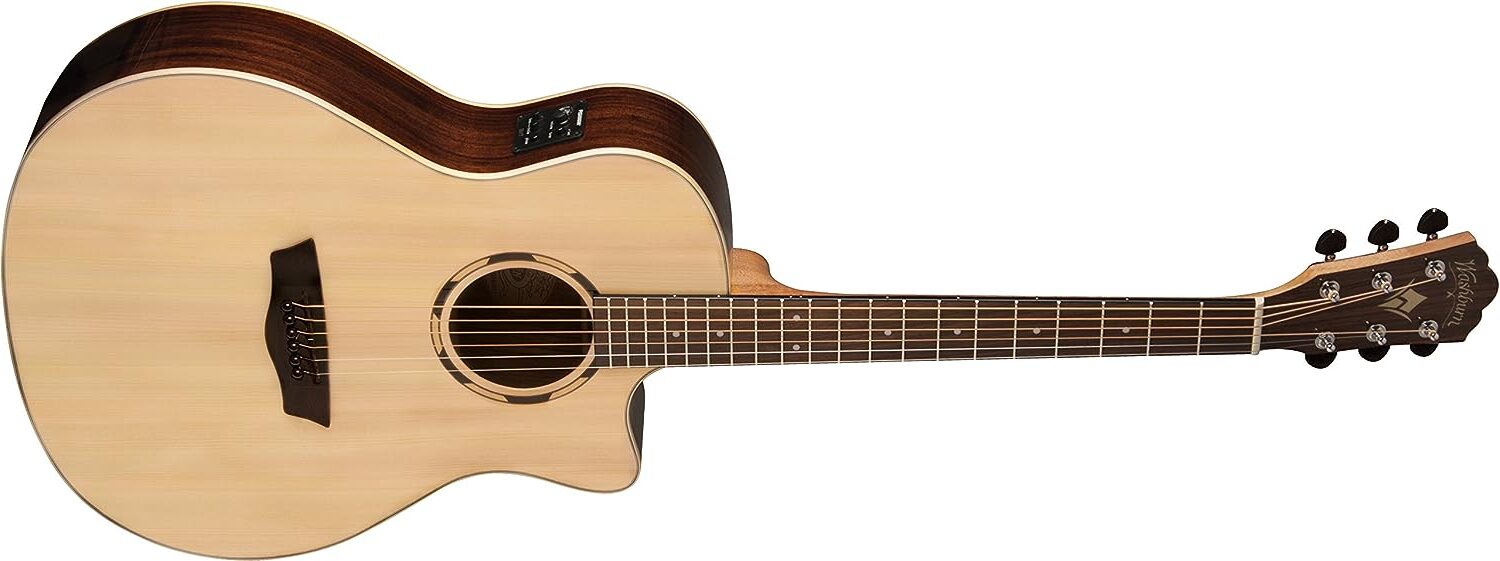
Introducing the Washburn Woodline Series WLO20SCE Acoustic-Electric Cutaway Orchestra Guitar in a striking natural colour.
Designed with the accomplished musician in mind, this instrument offers an enticing blend of sophistication, musicality, and cost-effectiveness.
The body of this guitar is fashioned from majestic Sitka spruce combined with rosewood, a top-notch combination for superior sound.
In addition, it features a well-thought-out single cutaway and boasts quartersawn scalloped bracing, perfect for the guitarists seeking precision and versatility in their playing.
The neck is crafted from strong mahogany wood, presenting a satin finish and 20 clean frets on a rosewood fingerboard.
Moreover, this right-handed guitar flaunts a 25.5-inch scale length, and it’s adorned with six resilient strings.
Thanks to its convenient pickup/preamp feature, it’s the go-to guitar for an array of occasions, from casual songwriting sessions to performances on stage.
The guitar stands out for its solid soundboards, ensuring excellent tone, while its classy maple binding evokes the elegance found on handmade instruments.
The low damping properties of the Graph Tech NuBone nut and saddle enhance the instrument’s tone and character to a significant extent.
In terms of performance, the Fishman 301T tuner/preamp guarantees natural sounding acoustic tones for a memorable music experience.
Without overemphasizing, the Washburn Woodline 20 Series truly embodies a balance of affordability, elegance, sound, and stability, tailored to meet the aspirations of singer-songwriters or finger-stylists. Case sold separately.
- My Review
Playing the Washburn Woodline Series WLO20SCE Acoustic-Electric Cutaway Orchestra Guitar has proven to be an absolute delight.
From the moment I had it in my hands, I could appreciate this instrument’s exceptional craftsmanship and quality.
Despite being priced significantly lower than some other brands, it boasts many high-quality materials, including Sitka Spruce for the top wood, and Rosewood for the back, sides, and fingerboard.
Another thing that strikes me about this guitar is how light it is.
Even with all the solid woods and the cutaway design, it feels comfortable and easy to handle, making it ideal for longer jamming sessions.
One could not help but notice the stunning rosewood and maple binding which adds a touch of sophistication to the guitar.
Visually pleasing, it certainly makes it stand out, appearing notably elegant among its competitors.
On the musical aspect, I got to admit that the sound quality of this guitar caught me by surprise.
Its Solid Sitka spruce top generates an impressive tone, lending itself to various playing styles such as finger-style and songwriting.
Jamming in an unamplified setting was no issue with this model, however, the integral Fishman 301T tuner/preamp truly comes into its own in a performance environment.
It provides a natural sounding acoustic tone that complements the guitar’s built-in qualities perfectly.
Adding to this, the Graph Tech NuBone nut and saddle enhance the tone and character of your guitar even further.
It’s worth mentioning at this point, however, that the action on this model was slightly higher than I typically prefer.
But with a bit of adjustment, it became more to my taste.
Even with this minor inconvenience, the overall performance and quality of the Washburn Woodline Series WLO20SCE Acoustic-Electric Cutaway Orchestra Guitar surpassed my expectations.
This instrument is undoubtedly the epitome of the perfect balance of affordability, elegance, sound, and stability, making it an ideal choice for forguitarists across the board.
- Pros:
- Exceptional build and finish.
- Comfortable and smooth fingerboard.
- Good amplified sound.
- Cons:
- No significant negatives were found.
My final verdict is that the Washburn Woodline Series WLO20SCE Acoustic-Electric Cutaway Orchestra Guitar is a fantastic investment for any musician.
This guitar offers a perfect balance of elegance, musicality and affordability that is hard to find in other models.
Its solid Sitka spruce top and quality craftsmanship allow for great tone and beautiful aesthetics.
Whether you require a guitar for songwriting, finger-style playing, church music or live performances, the Washburn WLO20SCE could be perfect.
Simply put, this guitar offers exceptional value for its price.
Epiphone Masterbilt Excellente Acoustic-Electric Guitar
Iconic design meets modern tech in Epiphone masterpiece.
This acoustic electric guitar features sturdy Epiphone hardware with a 25.5″ scale, 20 medium jumbo frets, and a 1.68″ bone nut. Made with Ovangkol wood back and mahogany neck, it sports an ebony fretboard with historic “cloud” inlays. The state-of-the-art Fishman Sonitone Onboard Preamp System ensures authentic acoustic sound in any setting.
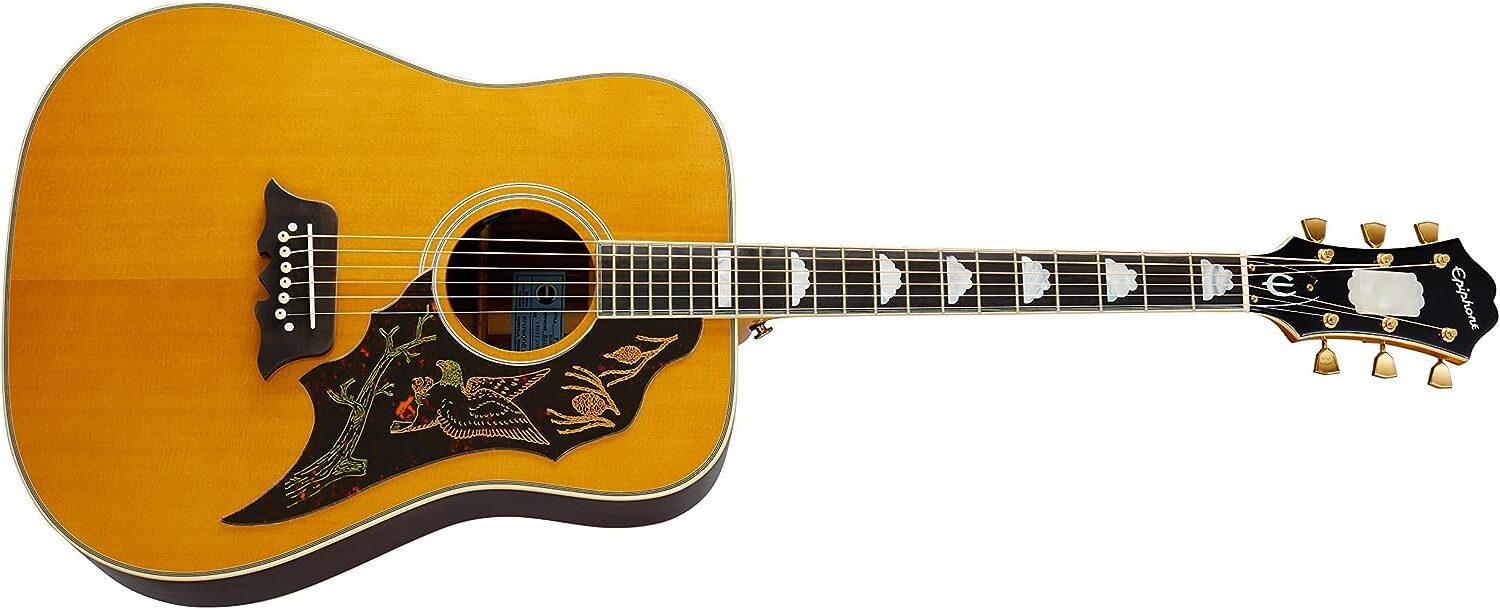
An iconic example of Epiphone artistry is the Masterbilt Excellente Acoustic Electric Guitar, which perfects antique natural aged aesthetics.
The guitar is fitted with features consistent with Epiphone’s reputable craftsmanship, showing a keen attention to detail with its 25.5-inch scale length, 20 medium jumbo frets, a 12-inch radius and a bone nut width of 1.68 inches.
Epiphone employs Ovangkol Wood for the guitar back, a sturdy material revered by many for its resonance and superior tonal quality.
The mahogany neck and the fretboard made from ebony wood, adds to the high-quality build of the guitar, ensuring sweet sounding notes and a deep warm tone.
Made settings-friendly through the integration of the state-of-the-art Fishman Sonitone Onboard Preamp System, the guitar guarantees acoustic output that remains true to its sound, irrespective of location.
The guitar is right-hand oriented and is strung with six strings for versatile playing – whether strumming chords or fingerpicking melodies.
Guitar dimensions stand at approximately 43.5-inch length, 20.79-inch width, and an 8.62-inch height which make it a standard-sized instrument and good fit for most players.
The distinct fretboard showcases the historic ‘Cloud‘ inlays, true to its design heritage, carrying on the spirit of Epiphone’s iconic 1960s acoustic guitars, worn by Country music giant, Loretta Lynn.
Its distinction lies in Epiphone’s successful attempt at recreating the rare square shouldered dreadnought, making this model a musical instrument of exceptional character.
- My Review
Having experienced the Epiphone Masterbilt Excellente Acoustic Electric Guitar first-hand, I was incredibly impressed by the elements it brought to the table.
I can confidently say that the beautiful Antique Natural Aged finish adds a unique touch, presenting an eye-catching interface that is sure to attract any music enthusiast.
The guitar incorporates solid Epiphone hardware, which means that it is aesthetically pleasing and uses high-quality materials – notably, we’re talking about Ovangkol wood and a neck made from mahogany here.
This combination attests to its durability while providing a rich, warm tone that enhances the overall sound.
Moreover, the ebony wood fretboard is a prime feature that provides a smooth and slick feel under the fingers making it easier to play for long periods.
Adding to its playability is the 25.5” scale and 20 medium jumbo frets, which satisfy any player, whether a beginner practicing chords or a seasoned player indulging in complex solos.
Yet, as we dive deeper into the playing experience, it would be remiss not to mention that some aspects could have been executed with more finesse.
Despite the guitar looking beautiful with its now rare square-shouldered dreadnought, and sounding wonderful thanks to the combination of the solid Sitka spruce top and Ovangkol body, the lack of precision during assembling is unsatisfactory.
The misalignment between the bridge and fingerboard is hard to miss, which could affect the consistency of the performance.
For instance, even if it doesn’t interfere with the guitar’s ability to produce crisp, mellifluous sound, it does make it a challenge to be effective in the upper registers – this is a result of the bass e-string bordering on leaving the fingerboard.
Similarly, the nut, which is not glued in, and the uneven frets complicate the playability to some extent.
Fortunately, the guitar retains its charm with the inclusion of the Fishman Sonitone Onboard Preamp System.
This modern feature ensures the beautiful acoustic sound of the guitar is maintained when plugged in, allowing the flexibility to play it in various environments without any loss in tone quality.
The Epiphone Masterbilt Excellente Acoustic Electric Guitar is indeed excellent, oozing character and authenticity despite some of the aforementioned issues.
- Pros:
- Great sound and feel.
- Attractive design and build.
- Equipped with modern preamp system.
- Cons:
- Misalignment in bridge and fingerboard.
- High and uneven frets.
- Potential issues with assembly quality.
My final verdict is that the Epiphone Masterbilt Excellente Acoustic Electric Guitar offers an impressive blend of quality and performance.
With its solid Epiphone hardware and old-world Masterbilt techniques, this guitar appeals to both nostalgic players and modern-day musicians.
The combination of its Solid Sitka Spruce top and Ovangkol body delivers a rich and resonant tone that will surely delight any guitarist.
Furthermore, its historic “Cloud” inlays not only offer a perfect adornment but also add a sense of class to the instrument.
Lastly, the integration of the Fishman Sonitone Onboard Preamp System makes it a highly versatile guitar, useful for both practice and performance scenarios.
Taylor 814ce Acoustic-Electric Guitar
Exceptional sound with diverse, high-quality materials.
This is a 6-string acoustic-electric guitar with a spruce top, Indian rosewood back and sides, V-Class bracing, and mahogany neck. It exhibits a natural color, and is made from an array of top-quality materials ranging from ash and maple to rosewood, mahogany, and ebony. It’s designed for right-handed users and has a 25.5-inch scale length for enhanced playability.
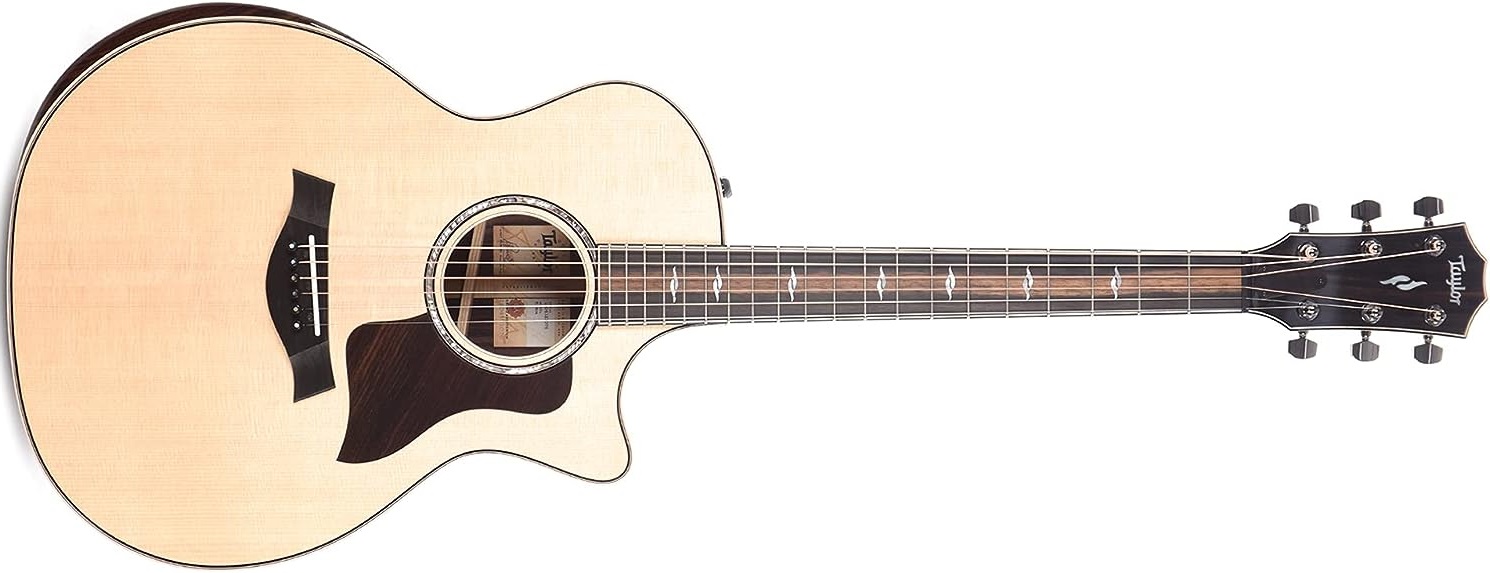
The Taylor 814ce is a finely crafted acoustic-electric guitar that strikes a perfect balance between aesthetic appeal and premium performance.
Boasting a natural hue, its construction features distinguishable Indian Rosewood on the back and sides, altogether contributing to a rich and resonant sound.
What makes this guitar even more special is its top, a blend of unparalleled materials such as Ash Wood, Maple Wood, Rosewood, Mahogany Wood, Ebony Wood, and Spruce Wood. This blend lends itself to a unique tonal quality, not common in most guitars.
The neck, constructed of mahogany, and an ebony fingerboard promotes ultimate playability and top-tier longevity.
This guitar sports V-Class bracing, an innovative concept aimed at maximizing volume and sustain while providing unmatched intonation.
A thoughtful addition is the radiused armrest, designed to deliver comfort and ease during long playing sessions.
Equipped with nickel strings, the Taylor 814ce resonates with a crisp, bright tone suitable for virtually any genre.
This right-handed instrument features a scale length of 25.5 inches, offering ample room to play comfortably across all frets.
Entitled as Sumptuous 814ce by Taylor, this guitar indeed lives up to its name, providing a lush and full-bodied sound, which a guitarist of any level would appreciate.
- My Review
Upon first look, the Taylor 814ce Acoustic-Electric Guitar reveals its delightfully natural color derived from various types of wood.
Being a person who values music, I was immediately drawn in by the amalgamation of ash, maple, rosewood, mahogany, ebony, and spruce that makes up the top material.
The body and back material, primarily made of rosewood and mahogany, added to my admiration for this outstanding piece of musical craftsmanship.
The fingerboard and neck, built from mahogany, not only add to the guitar’s aesthetically pleasing appearance, but also provide a smooth and comfortable surface to play on.
Undeniably, the strings of a guitar play a critical role, and the fact that this guitar utilizes nickel strings speaks volumes about its quality and longevity.
Being right-handed, I find the guitar’s right-hand orientation very user-friendly and practical for my playing style.
The scale length, measuring at 25.5 Inches, seems to be quite ideal for an acoustic-electric guitar, thus enhancing playing comfortability and convenience.
To my surprise, the guitar also features a unique Radiused Armrest that promotes better access to the higher frets and improves overall playability.
On strumming the Taylor 814ce, the spruce top coupled with V-Class Bracing sings out with immaculate clarity and resonance.
The combination of the quality of materials and the V-Class Bracing technology makes it a guitar that truly stands out in terms of sound quality and sustain.
The sound it produces is sumptuous, bathed in rich overtones that give it a deep, full sound.
What I truly love about this guitar though is its versatility and adaptability, allowing me to switch between genres and styles without having to change instruments.
Preliminary thoughts about this product are overwhelmingly positive, and from the feel, to the design, to the sound, it’s definitely a guitar I would recommend to any serious musician or hobbyists alike.
- Pros:
- Comes with V-Class bracing.
- Indian Rosewood on the back and sides.
- Ebony fingerboard.
- Cons:
- No significant negatives were found.
My final verdict is that the Taylor 814ce Acoustic-Electric Guitar – Natural with V-Class Bracing and Radiused Armrest is an excellent choice for serious professional musicians and hobbyists alike.
The guitar’s spruce top, Indian Rosewood back and sides, and Mahogany neck combine to deliver a rich, multi-dimensional sound that resonates beautifully.
Combined with a V-Class Bracing, it provides superb durability and robust build quality, encouraging long-term usage.
Moreover, the hand orientation and scale length make it accessible and comfortable for a wide range of players.
This guitar is an outstanding investment, offering superior sound and build quality.
Blueridge BR-160 Historic Series Acoustic Guitar
Vintage-style dreadnought with rich, robust sound.
Featuring a solid Sitka spruce top with scalloped braces, the guitar delivers crisp articulation and a robust tone. It boasts a slim mahogany neck for seamless action, coupled with an East Indian rosewood back and sides for deep bass and potent cutting power. The stylish dreadnought exudes a vintage 30s aesthetic with a tortoise style pickguard, and offers smooth playability with its East Indian rosewood fingerboard.
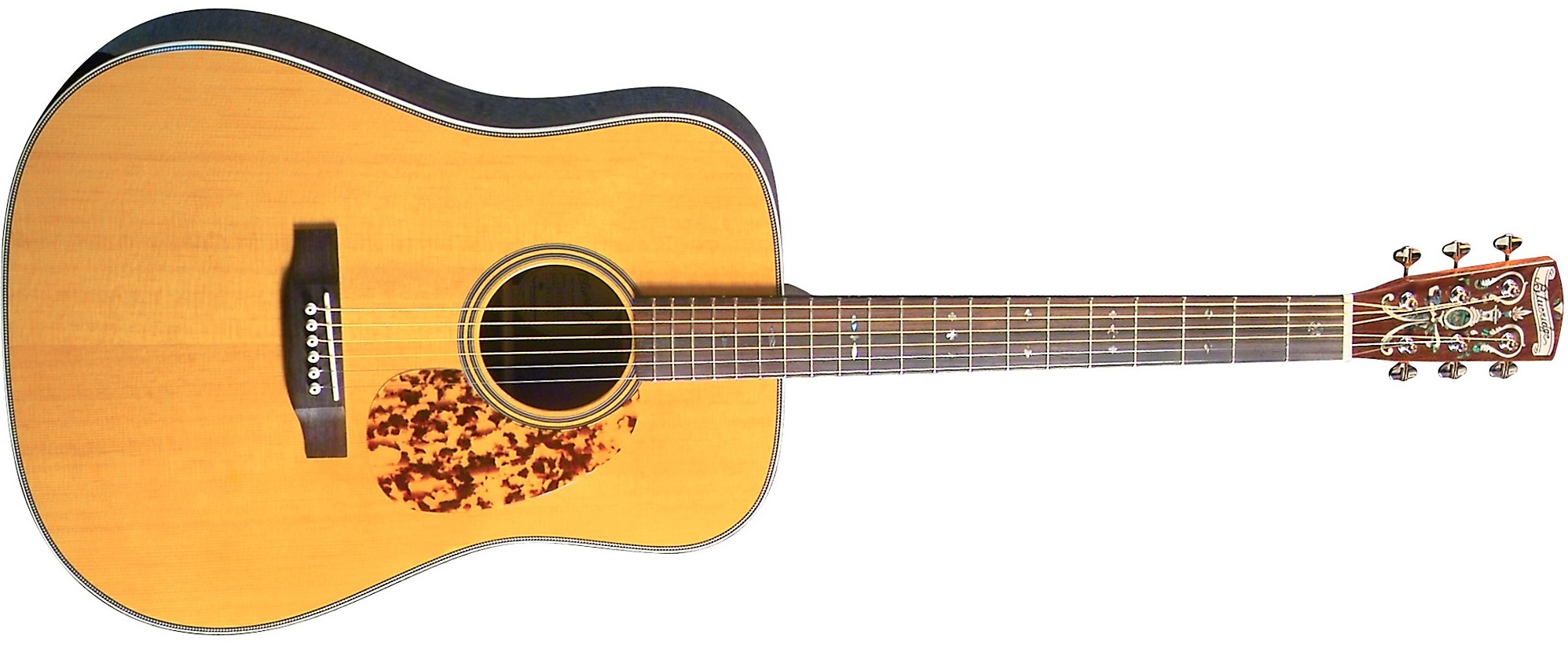
This Blueridge BR-160 Historic Series Dreadnought Guitar truly captures that vintage look from the 1930s with its distinctive tortoise style pickguard.
It possesses a solid Sitka spruce top with scalloped braces, perfect for producing a distinct, clear tone and articulate sound.
The back and sides are made of solid Indian rosewood, promising a robust bass and excellent cutting power.
The neck, designed in a slim shape and constructed of mahogany, provides both speedy and comfortable action along with long-lasting stability.
The addition of a East Indian rosewood fingerboard not only ensures a smooth playing experience, but greatly enhances the guitar’s overall richness and elegance.
Manufactured by the respected brand Blueridge Guitars, the instrument is right-hand oriented and has the bridge system built from rosewood.
The body and top materials are made from a mixture of Spruce and East Indian rosewood, complemented by a Mahogany neck, making this guitar both durable and beautiful.
Decorated with mother-of-pearl inlays on the neck and headstock, the guitar exudes an undeniable charm.
This guitar’s herringbone pattern is inspired by the prewar era, complete with a handcarved parabolic top, dovetail neck joint, and adjustable truss rod.
The stringing is done using Phosphor Bronze, further accentuating the overall sound quality of the Banjo.
- My Review
From the moment I laid my hands on the Blueridge BR-160 Historic Series Dreadnought Guitar, I could immediately feel its quality and craftsmanship.
Lovingly made with a Solid Sitka spruce top, it promises a crisp tone and clean articulation, that is to my delight, it immensely delivers.
What really stands out to me is that the scalloped braces notably enhance its tone.
The design of the back and sides made of solid Indian rosewood provides not just aesthetic beauty, but also enriches the sound by guaranteeing a deep bass and powerful cutting ability.
I appreciate the slim mahogany neck, a key component that allows fast and easy action.
The long-lasting stability it offers is indeed a testament to the guitar’s inherent resilience and longevity.
When it comes to the fingerboard, Blueridge chose East Indian rosewood, ensuring a smooth playability which makes every strum a pleasurable experience.
The tortoise-style pickguard adds a vintage 30’s look, contributing to the overall aesthetic value of this guitar.
Playing this guitar is not just a simple strumming experience, the deep, resonant sound it produces echoes in my mind even after I have stopped playing.
There is something rather striking about the bountiful sound and elegant design – a prime example of blending aesthetics and functionality.
I believe that the Blueridge BR-160 Historic Series Dreadnought Guitar’s appeal lies in its excellent balance of design and sound quality.
It is an instrument worthy of being chosen as a companion for both experienced players and aspiring beginners.
Indeed, the slight flaw of the missing strap button on the heel does not greatly influence my positive impression of this guitar.
Although it is crafted in China, this does not detract from the charm and quality of the guitar. The sound and the longevity is what truly matters.
Finally, making music with this particular guitar feels like revisiting the classic era of acoustic guitars, while simultaneously enjoying modern improvements in guitar design and technology.
Truth be told, the Blueridge BR-160 Historic Series Dreadnought Guitar has exceeded my expectations in terms of both visual appeal and performance. It is a guitar that I would, without hesitation, proudly add to my collection.
- Pros:
- Versatile, full sound characteristics.
- Beautiful and finely detailed craftsmanship.
- Strong durability and long-lasting stability.
- Cons:
- Slight quality variance between products.
- Aesthetic modifications may be desired.
My final verdict is that the Blueridge BR-160 Historic Series Dreadnought Guitar is a true gem.
Its solid Sitka spruce top and Indian rosewood back and sides offer a perfect mix of a clean, crisp tone and deep bass.
The slim mahogany neck and East Indian rosewood fingerboard ensure easy action and smooth playability.
When it comes to aesthetics, the distinctive tortoise style pickguard and the 30’s vintage look add a touch of charm.
It offers great sound, great looks, and high quality build, fully justifying its demand among vintage style acoustic guitars.
LAVA ME 2 Acoustic-Electric Carbon Fiber Guitar
Versatile, lightweight carbon fiber guitar with effects.
Constructed from Super AirSonic carbon fiber, this lightweight unibody guitar provides rich, dynamic sound and is resistant to harsh weather conditions, making it ideal for travel. Its unique L2 Preamp with FreeBoost Technology allows for versatile sound manipulation, using the back of the guitar as a speaker. In addition, a precision machined FlyNeck offers effortless playability across all frets, ensuring a comfortable playing experience.

The LAVA ME 2 Acoustic-Electric Carbon Fiber Guitar boasts a unibody construction that eliminates the need for excessive glue, resulting in a versatile instrument that remains lightweight at 3.7 pounds.
This design also improves sound production, providing a broader range of frequencies.
Complementing the guitar’s innovative construction is the L2 Preamp which comes with FreeBoost Technology.
This inventive feature remarkably transforms the guitar’s back into a speaker, allowing you to amplify sound and manipulate it using built-in reverb, delay, and chorus effects.
The preamp also incorporates a specialized mic to pick up and enhance percussion sounds – all these without even cord connection.
The performance of the guitar is further boosted with the Plek’d FlyNeck feature.
Precisely constructed using a Plek Pro machine to an exactness of 0.01mm, ensuring minimal string height for easy play and excellent tuning stability.
This FlyNeck is carefully designed based on detailed data from finger movements, offering effortless transition across the fretboard.
Constructed from an ultra-durable Super AirSonic carbon fiber material, the LAVA ME 2 is resistant to extreme temperature and humidity, making it perfect to take along on any adventure.
It’s reliable and sturdy under varying environmental conditions, from arctic cold to desert heat.
The product comes as a complete guitar package, which includes a handy carrying bag, a mix of Ideal Picks, a charging cable, and a cleaning cloth. Suited for right-handed players, this guitar features Phosphor Bronze strings.
The LAVA ME 2 is predominantly made from Carbon Fiber, with the neck and fretboard made from high-pressure laminate (HPL).
It features an L2 pickup system, transforming your sound experiences with FreeBoost features.
- My Review
Upon first laying my hands on the LAVA ME 2 Acoustic-Electric Carbon Fiber Guitar, I was both pleasantly surprised and mildly concerned.
Unsurprisingly, its lightweight construction made it both highly portable and comfortable to hold for extended play.
Kudos to the designers for including a Unibody design, creating a visually appealing aesthetic and a wide frequency range, giving this guitar the ability to produce resonant, dynamic sound.
What was truly remarkable was the FreeBoost technology incorporated into the L2 Preamp, which allows the back of the guitar to double as a speaker. This ingenious and useful feature provides the ability to shape sounds with reverb, delay, and chorus effects.
Moreover, the built-in percussion sound enhancing mic opens even more possibilities, presenting opportunities for some innovative playing techniques.
However, I have to admit that there was a tad bit of disappointment regarding the action, which was somewhat higher upon arrival than I’d usually prefer, but nothing that a bit of tweaking couldn’t fix.
Moreover, while the Plek’d FlyNeck is a marvel of engineering, with its high precision and low string height, the guitar’s overall playability was somewhat affected by its narrow string spacing.
Despite the slight discomfort for larger hands, this guitar scores high on resilience and adaptability, thanks to its Super AirSonic carbon fiber material that makes it weatherproof and apt for extreme conditions.
Imagine strumming away on a hot desert day or in a frosty polar region – this guitar is equipped for anything and everything!
I also appreciate the thoughtfulness of the designers in creating a complete package that includes an Ideal bag, pick, charging cable, and cleaning cloth.
On the flip side, it is essential to mention the slight imbalance in terms of weight distribution, which could make the guitar’s neck feel heavy and unwieldy if not supported properly, and the absence of inlays on the fretboard might be a bummer for some.
The onboard effects, while fun to experiment with, may come across as superfluous to some players who prefer the simplicity and purity of acoustics.
The sound is impressive overall, with lots of bass for its small size, but lacks the resonance and volume of traditional wooden guitars. Furthermore, the lack of pocket in the case is mildly annoying as there’s no place to store picks or a capo.
My perception of the LAVA ME 2 is mainly positive, but it’s not without its shortcomings.
Like all guitars, it comes with its unique quirks and character which some may love and others less so, but in the end, it’s all about finding a tool that will inspire you to create beautiful music, and the Lava ME2 definitely has the potential to do just that.
- Pros:
- Impressive onboard effects.
- Weather resistant.
- Comfortable and lightweight.
- Cons:
- String spacing is tight.
- Case lacks storage compartment.
- Can have setup issues.
My final verdict is that the LAVA ME 2 Acoustic-Electric Carbon Fiber Guitar is an unrivaled masterpiece in guitar innovation.
Its Unibody design, multi-effects L2 Preamp, FlyNeck, and Super Airsonic carbon fiber construction make it a joy to play, and the versatile, resilient, and portable features only serve to amplify its appeal.
Not only does it sound fantastic, but it’s built to withstand extreme weather conditions, making it ideal for a variety of playing environments.
This product really does offer a complete guitar package, including some excellent extras such as an ideal bag and picks.
The LAVA ME 2 delivers an outstanding performance that both professional and beginner guitarists will appreciate.
What to Look for When Buying Professional Acoustic Guitars?
When making the decision to purchase a professional acoustic guitar, there are several vital factors to consider.
The first important consideration is the type of wood used in the guitar’s construction.
Each type of wood impacts the guitar’s sound and resonance in distinct ways.
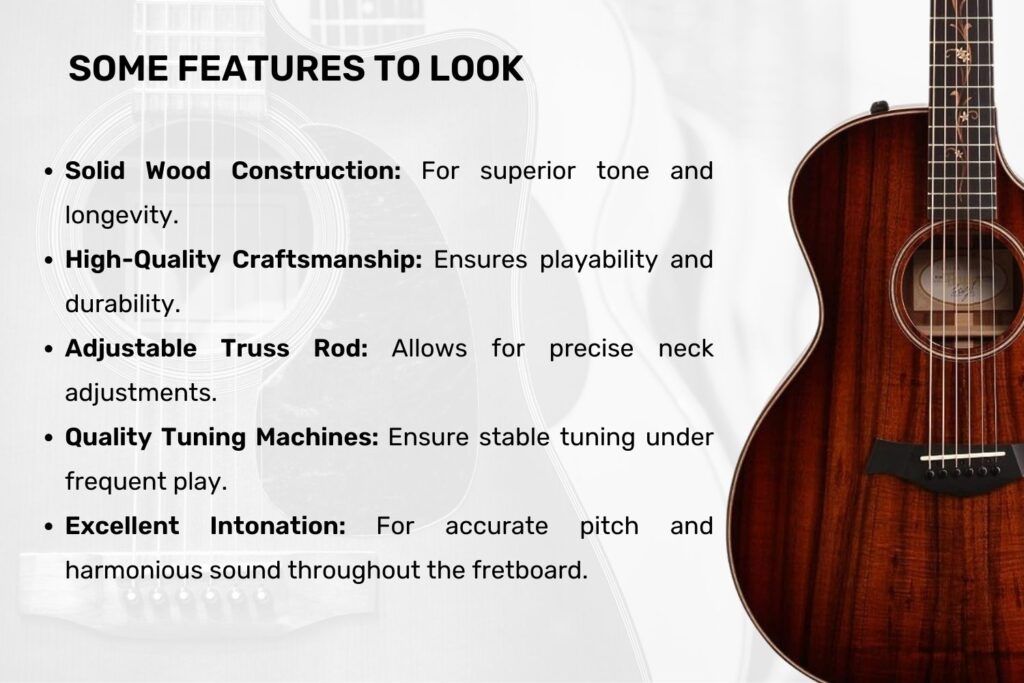
For instance, Cedar provides a great mid-range while Sitka Spruce offers a wider tonal range.
Next, the guitar’s shape and size play a considerable role in the instrument’s playability and also contribute to its overall sound.
Smaller-bodied guitars are more comfortable to play and often offer a more bright, focused sound, while larger bodies provide a richer, more resonant tone.
The quality of the guitar’s construction is another key element to consider.
Inspect the guitar closely for any signs of poor craftsmanship such as bad finishes, loose bracings, uneven frets, or poorly set up bridges.
A high-quality guitar should feel solid and well-constructed, with no buzzes or rattles when played.
The brand of the guitar can also be an important consideration, as different brands often have different reputations for quality.
It’s worth researching the reputations of different brands and reading reviews from other guitarists.
The guitar’s neck construction is another crucial consideration, as it can significantly affect the instrument’s playability and tone.
Necks can be either set, bolt-on, or neck-through, each with its own benefits and drawbacks.
Finally, the type of strings used will greatly affect the guitar’s sound.
Lighter gauge strings are generally easier to play, but may not provide as much volume or sustain as heavier gauges.
When choosing a set of strings, consider what type of music you plan to play and choose accordingly.
Beyond these considerations, other factors such as the guitar’s price and its resell value may also be important to consider.
Remember, an investment in a quality instrument will not only enrich your musical journey but can also provide a sound financial investment over time.
Lastly, remember that the guitar is a delicate instrument that requires regular care and maintenance to function at its best.
Take the time to learn about proper guitar maintenance, including regular tuning, changing strings, and cleaning to protect your investment and ensure your guitar continues to sound its best.
How Different Woods Impact the Guitar’s Sound?
As with any musical instrument, acoustic guitars are more than just the sum of their parts.
One critical aspect that brings these instruments to life is the material they’re made of – wood.
The type of wood used in the construction of a guitar can significantly impact the guitar’s sound, feel, and overall performance.

There are many different types of wood that can be used, each with unique properties that contribute to the guitar’s overall sound and playability.
Mahogany, for instance, is a popular choice for many guitar manufacturers.
As a wood, mahogany is known for its density and ability to produce warm, thick sounds, making it a popular choice for blues and rock musicians.
In contrast, spruce is known for its clarity and dynamic range, making it a great choice for more nuanced, fingerstyle play.
Due to its bright tonal properties, it’s often used for tops of acoustic guitars which heavily influence the overall tone of the instrument.
Similarly, other types of wood like cedar and rosewood are also popular choices for their specific sonic characteristics.
Cedar is known for its rich and responsive nature. It is often used on nylon stringed guitars and loves a light touch, making it a popular choice among classical and fingerstyle players.
On the other hand, rosewood is known for its bright trebles and deep basses.
It has a wide tonal range that reacts well to a variety of playing styles, from fingerpicking to hard strumming, thus is used for both back and sides of a guitar.
Besides the type of wood, it’s also important to consider the craftsmanship of the guitar and how the wood has been treated.
The quality of construction can significantly impact the resonance and sustainability of the guitar’s notes, affecting the overall quality.
As a general rule, solid wood guitars tend to have a richer, louder sound than guitars made from laminated wood, although they are often more expensive.
It’s also worth noting that the age and condition of the wood used in a guitar’s construction can also have an impact on the instrument’s tone.
Older guitars, for instance, often have a warmer, richer sound than newer instruments due to the woods maturing over time.
When choosing an acoustic guitar, it can help to have an idea of the tonal qualities you are looking to achieve, and then choose a guitar made of wood that offers these characteristics.
The important thing to remember is that there is no right or wrong answer, and your preferences will depend on your individual playing style and personal taste.
Understanding the characteristic of different woods is just the first step to selecting a guitar that will enhance your playing experience and bring your music to life.
It’s a combination of feel, sound, and personal connection that will ultimately lead a musician to their perfect instrument.
So, taking the time to try out different woods and listening to the unique tones they produce is a vital step in the process of selecting not just a beautiful looking guitar, but one that sounds and feels right to you.
Should You Consider the Brand When Buying a Professional Acoustic Guitar?
When entering the market to purchase a professional acoustic guitar, many factors come into play as predictors of the quality, sound, and overall satisfaction with the instrument.
It is a multifaceted decision that extends far beyond the look of the guitar itself.
One of the considerations that consistently emerges is the influence of the brand on the final buying decision. Brand loyalty or perception often impacts the buying process – sometimes subtly, sometimes profoundly.
In the world of acoustic guitars, some names stand out more than others due to their longevity, the legendary musicians who have played them, and the unswerving quality they have delivered over the years.
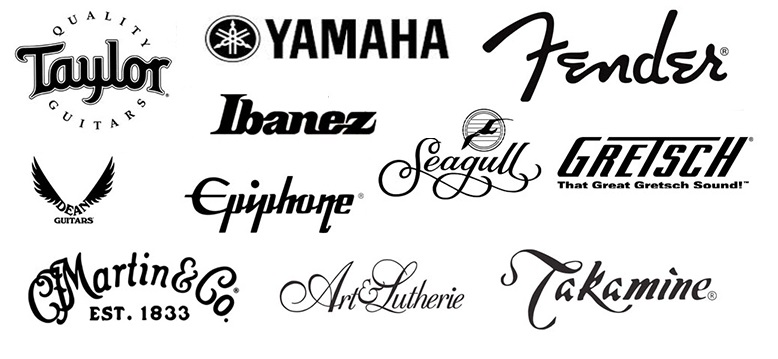
Brands such as Martin, Taylor, and Gibson are often on the lips of professionals and serious guitar enthusiasts alike when discussing top tier acoustic guitars.
In the sphere of professional acoustic guitars, the reputation of a brand matters substantially. This is not primarily due to marketing or aesthetic appeal, but more because of the consistency, quality, and longevity offered by the brands.
However, it’s vital to realize that recognizing a brand is only part of the equation.
Instead, one should consider the brand as a gateway to understand more about the specific models, their characteristics, the quality of craftsmanship, and the tonal properties each guitar holds. These intricate details hold more weight than the brand’s name itself.
When it comes to professional acoustic guitars, established brands tend to be more consistent in the adherence to quality craftsmanship and excellence in material selection.
Furthermore, brands associated with professional-quality instruments are more likely to have thorough and detailed quality control measures in place.
At the professional level, this attention to detail can significantly influence how the instrument performs in the long run.
Quality consistency and material selection extend the instrument’s lifespan and maintain its tonal quality.
Therefore, considering brands known for their commitment to excellence isn’t about buying into ‘hype’ or ‘name-dropping,’ it is more about investing in consistency, longevity, and meticulous craftsmanship.
Another reason to consider the brand is the accessibility and availability of customer service and support.
High-quality brands tend to offer reliable customer support and warranties, which will both give you peace of mind and help you to address any potential issues.
Remember, however, that relying on the brand alone as an indicator of a good guitar can lead to some pitfalls. It is just one factor among many.
Every guitarist’s needs are unique, and a guitar from a high-quality brand might not necessarily be the best fit for every individual’s playing style, musical genre, or physical characteristics.
As a result, it is essential to use the brand as just one of the many tools for identifying the right guitar rather than the sole determinant. Personal preferences, requirements, and individual style will ultimately define which guitar is most suitable.
Last but not least, it’s worth noting that great guitars can also come from lesser-known brands. Innovation and craftsmanship are not exclusively tied to large, historic companies.
Therefore, staying open to opportunities and trying out different brands can lead to some surprising discoveries.
Every brand has its story, its method, and its peculiarity, which is why each stands out in its way. What truly matters is the quality of the instrument and how it feels and sounds to the individual player.
How to Choose the Right Size Acoustic Guitar for Professionals?
When playing the guitar, comfortability is an essential factor. The size of the guitar and the ease of handling it can significantly influence your playing experience.
Different guitar sizes are built to cater to the variances in body types, hand sizes, and the comfort level for the players.
When choosing a guitar, you should start with identifying the body size and shape that is most comfortable and playable for your physique.
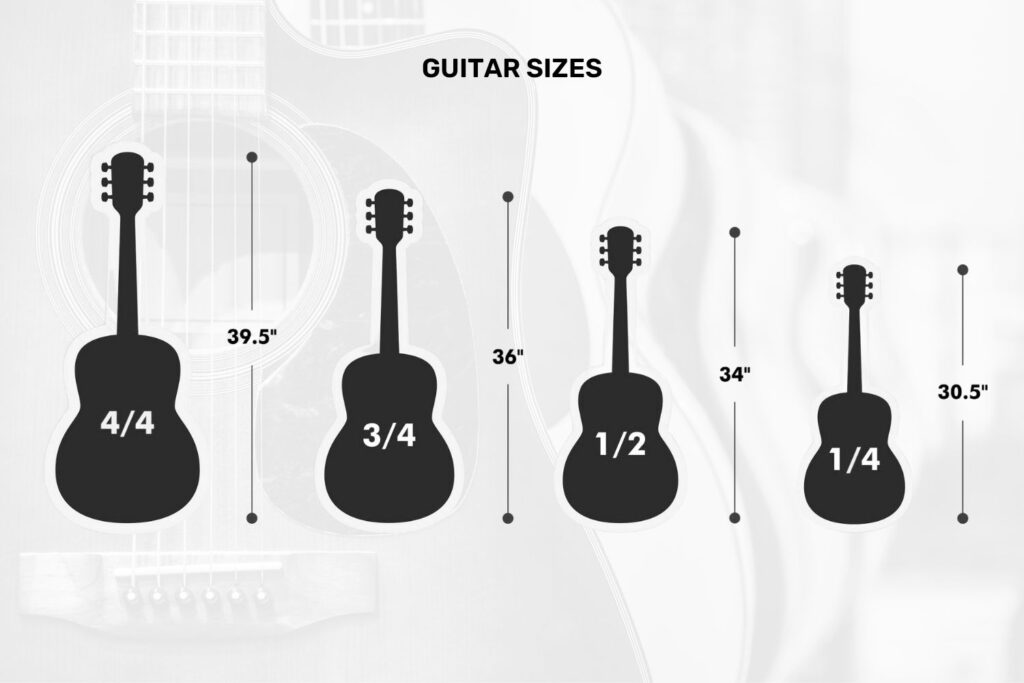
For this purpose, you can consider three main factors: the size and shape of the guitar, the playing posture, and the type of music genre you will be playing most of the time.
The size of the guitar is the most evident factor.
A larger guitar often comes with a louder volume and richer tone due to the large soundboard, but it may be difficult to handle for people with a smaller frame.
On the a contrary, smaller guitars are easier to handle and play, especially for those who prefer to play the instrument in a seated position.
Yet, they often lack the volume and resonance of a larger guitar.
A small-bodied guitar, like a parlor, concert or orchestra model, may be ideal for fingerpickers, while large-bodied guitars like the dreadnought or jumbo guitar can deliver a loud and bold tone suitable for strumming and flat picking styles.
Players with shorter arms may also find a guitar with a thinner body or smaller waist much easier to play.
Playing posture is another important aspect while working out the right guitar size.
Professional guitarists play in both sitting and standing positions, and the guitar size should align well with the chosen posture.
The guitar should feel comfortable and balanced whether you play it sitting or standing up.
Choosing a guitar whose body shape doesn’t align well with your playing position may lead to posture issues and discomfort in the long run.
In addition to the physical comfort, selecting a guitar size also depends on the style or genre of music you play.
Different guitar sizes often yield different tonal characters, which suit different music styles.
Larger guitars like dreadnought or jumbo have a powerful and balanced tone, making them suitable for strumming in styles like rock, pop, country, or bluegrass.
In contrast, smaller guitars like parlor, concert or orchestra models produce a gentler and more articulate tone, which can be more suitable for fingerpicking styles or folk music.
Last but not least, when deciding on the right size acoustic guitar, trying out a range of different size guitars can be immensely beneficial.
Even if two different guitars have identical specifications on paper, they could feel entirely different when you actually play them.
Therefore, taking the time to go to music shops and trying out different types and sizes of guitars can provide a more practical perspective and help in finding the guitar size that feels the most comfortable and natural for you.
Regardless of all these factors, the selection process of a guitar is a subjective matter and depends ultimately on your personal preference.
As long as you choose a guitar that feels comfortable to play and is able to produce the sound and tone that you desire, you’re on the right path as a professional guitarist.
How to Evaluate the Tone Quality of an Acoustic Guitar?
Evaluating the tone quality of an acoustic guitar requires a detailed understanding of the musical instrument’s construction and sound capabilities.
The tone of an acoustic guitar indicates the sound quality it produces, which takes into account its timbre, sustain, resonance, and balance
Tone is very much a subjective aspect, what might sound pleasing to you might not be the same for another guitarist.
An understanding of these terms can significantly help you choose a guitar with a tone quality that you find most comfortable and desirable.
The first step in evaluating the tone quality of a guitar is to acknowledge the importance of your ears.
Your personal preference plays a vital role in determining the tone quality of the guitar.
The guitar should sound good to you while playing.
Secondly, bear in mind that the body style of an acoustic guitar greatly affects its tone.
Dreadnought and jumbo guitars generally produce a loud volume and deep bass compared to smaller body styles like orchestra or parlour that produce a balanced sound.
Another significant consideration is the guitar’s wooden construction.
The type of wood that the top (soundboard) of the guitar is made of particularly affects its tone quality.
For instance, spruce-topped guitars are known for their bright and punchy tone, while cedar-topped guitars deliver a warm and mellow sound.
Consider the treble, mid, and bass frequencies of the guitar.
A high-quality guitar should produce a balanced sound, where none of the frequency bands overpower the others.
The guitar’s components, such as the strings, fretboard, and adjustments like the action (the height of the strings from the fretboard), also have a substantial impact on tone quality.
Keep in mind that new strings, when properly tuned, can enhance the sound quality of a guitar
Lastly, remember that the quality of the craftsmanship, fine details, and finish of a guitar contribute to its overall tone quality.
Look for signs of good craftsmanship like even frets, smooth neck, a well-set bridge, and the right neck angle.
Evaluating the tone quality of an acoustic guitar is a complex process, but with the correct knowledge and understanding, you can confidently distinguish between varying tones and choose the right guitar for yourself.
To improve your ability to assess tone quality over time, always play and listen to different types of guitars as often as possible.
Keep researching, exploring different brands, styles, woods, and always take your time in identifying what tone most appeals to your ears and style of music.
Remember, finding the perfect guitar with the right tone quality is not about the price or the brand, but more about how the guitar feels and sounds to you.
How To Take Care of Your Professional Acoustic Guitar?
Professional acoustic guitars, like any other musical instruments, require routine maintenance and care to maintain their peak performance and aesthetic appeal.
Understanding the particular needs of your guitar becomes paramount for any serious musician.
The first and most important step is preserving the right environment for the guitar.
Extreme temperatures and humidity levels can severely damage the wood of your guitar, causing it to warp or crack.
Therefore, storing your guitar in a hard shell case is highly advisable, when it’s not in use.

An instrument that is left out can easily become a victim of accidents and dust.
A guitar humidifier is also a worthwhile investment as it can help maintain optimal humidity levels, especially during cooler months when indoor heating can leave the wood dry and brittle.
Taking time to clean your guitar routinely is also crucial in taking care of your instrument.
Dirt, grime and sweat can accumulate over time, which can lead to discoloration and damage on the body and fretboard of the guitar.
To clean it, you could use a dry soft cloth to wipe down the strings and body after every use.
Moreover, using a specialized guitar cleaner every few months can also help extend the life of your guitar.
Changing the strings of your professional acoustic guitar on a regular basis is also integral.
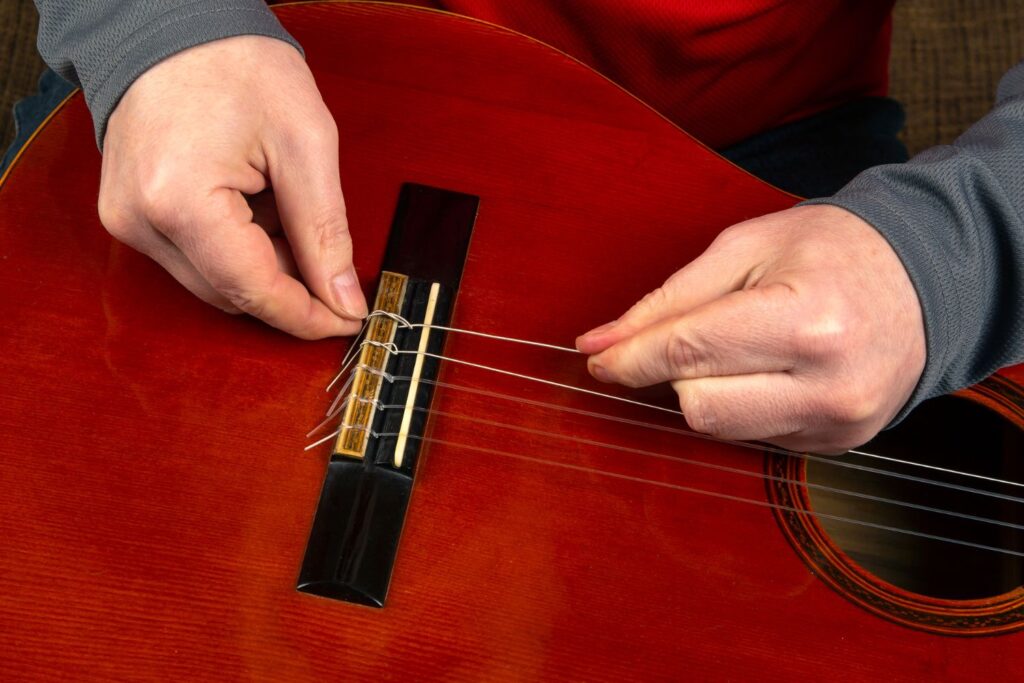
Old worn-out strings can impact the sound quality of the guitar.
Moreover, changing the strings gives you an opportunity to give your fretboard a good clean and oil if needed.
Evidently, the frequency in which you should change the strings depends greatly on how often you play but typically a span of three months is a safe bet.
In addition, it is prudent to take your professional acoustic guitar for an annual check-up to a professional.
They can inspect the instrument for any structural damage or issues that might not be readily visible to the untrained eye.
Frets may need a dressing and the neck might need an adjustment, for instance.
These are all intricate tasks that should ideally be handled by a professional to avoid any further damage.
It is not a sign of being overly cautious but an indication of your commitment, understanding, and respect for your musical tool.
Developing these regular maintenance habits can seem laborious to a new guitar owner, but they’re essential to prolonging the life of your guitar.
Remember, the professional acoustic guitar represents a significant investment, and it’s worth taking the time to learn how to properly care for it.
It will reward you with incredible sound, playability, and a long lifespan making it an invaluable asset in your musical journey.
Therefore, understanding and practicing the above-mentioned care routine can be your invaluable toolkit in preserving your professional acoustic guitar in its prime condition.
What Strings Are Best for Professional Acoustic Guitars?
When understanding what strings to opt for for professional acoustic guitars, several factors come into play.
Firstly, material plays a crucial role. Traditional acoustic guitar strings are composed primarily of bronze, phosphor bronze, steel or nickel.
Bronze strings are recognized for their bright, vibrant, and clear sound.
Steel strings on a professional acoustic guitar produce a bright, sharp, and clear tone with a lot of sustain, making them well-suited for various music genres, including rock, country, and folk.
On the other hand, nickel strings yield a warmer, softer, and more mellow tone, which can be preferable for jazz, blues, or vintage music styles.
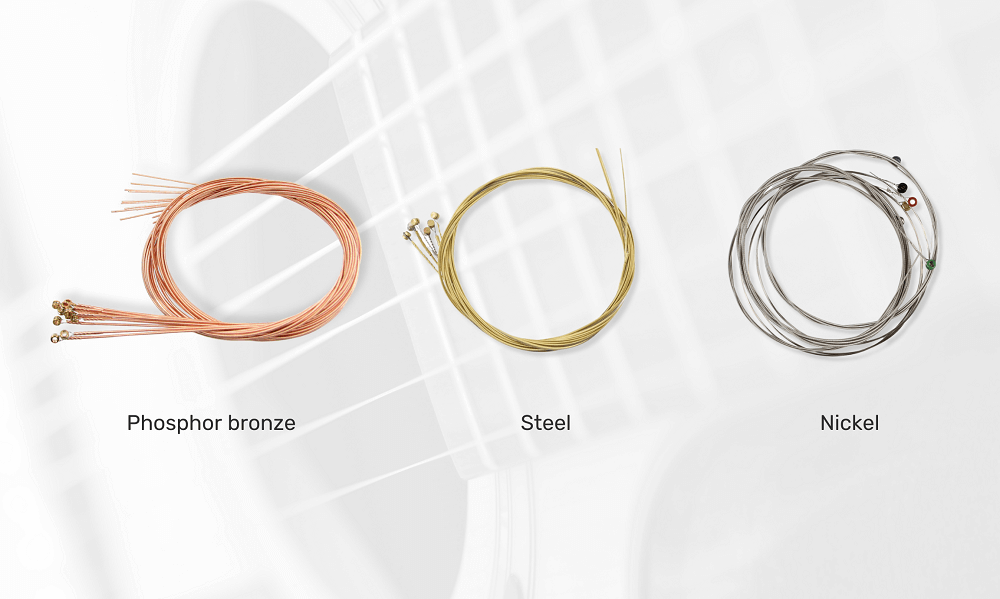
Meanwhile, phosphor bronze strings provide a warmer, smoother tone, which has made them a popular choice among many professional guitarists.
Secondly, it’s vital to understand that the thickness, also known as string gauge, deeply impacts the sound and playability of the guitar.
Light gauge strings are easier to press down and bend, but they tend to break more easily and offer less volume.
On the other hand, heavy gauge strings offer a louder, fuller sound but require more finger strength to press down and are harder to bend.
Beyond material and gauge, a professional guitarist should also consider coated versus uncoated strings.
Coated strings are shielded with a thin polymer film, which helps them withstand the elements better and last longer; however, some players feel that this coating slightly mutes the strings’ sound.
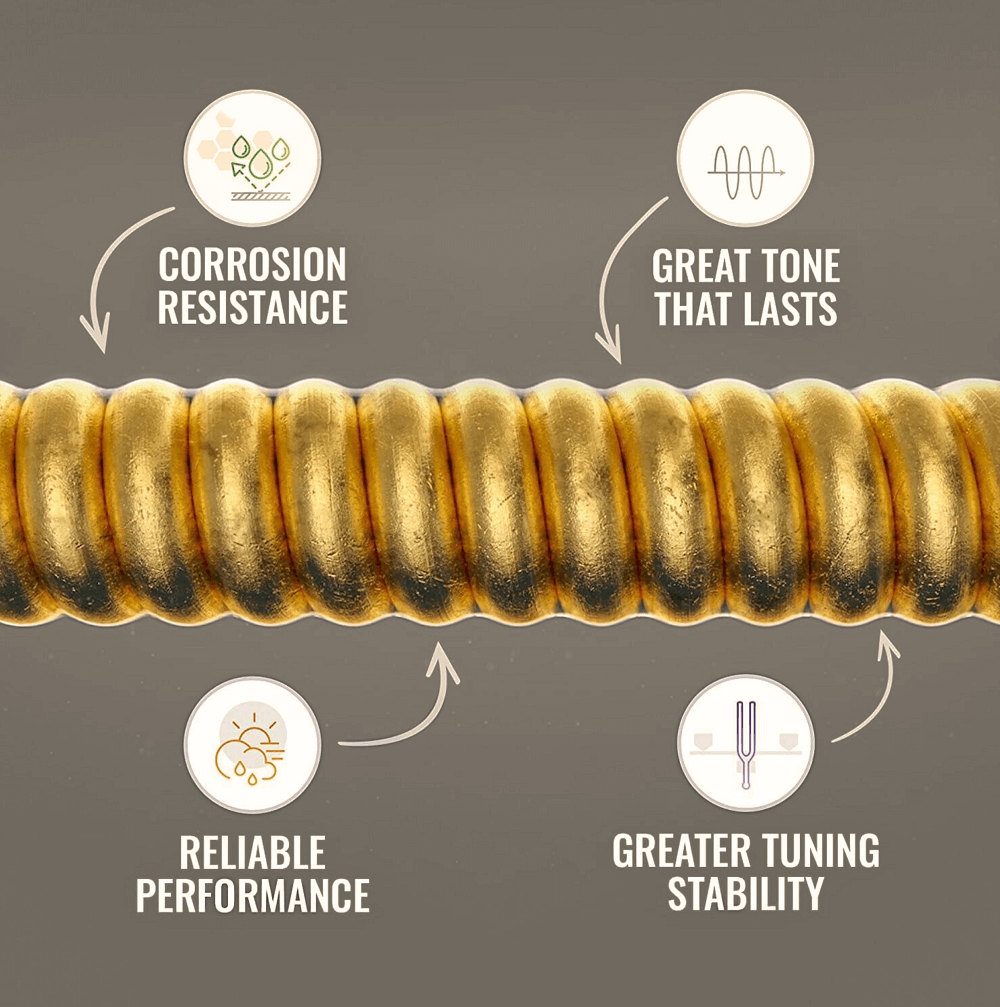
Uncoated strings, while offering a purer and brighter tone, are more prone to quickly lose their spark due to sweat and dirt accumulation.
Ultimately, choosing the correct strings is a matter of personal preference; what is most important is that the strings match the player’s style and taste.
For instance, a blues player who seeks a mellow, soulful, and warm tone might prefer medium-gauge phosphor bronze strings.
Simultaneously, a country player who aims for a crisp, bright, and twangy sound might opt for light-gauge bronze strings.
Regardless of the chosen strings, it’s essential to remember that even the highest quality strings will eventually degrade and lose their tone overtime.
Thus, professionals should make it a habit to regularly change their strings to keep their guitar sounding its best.
While there’s a multitude of strings suitable for professional acoustic guitars, the right choice ultimately hinges on the individual player’s tastes and needs.
Choosing the perfect strings might seem challenging, but through experimentation and practice, every guitarist can find the set that really resonates with their musical style.
Does The Shape Of An Acoustic Guitar Affect Its Sound?
The shape of an acoustic guitar is often overlooked, however, it plays a significant role in the overall sound production and playability of the instrument.
Variety in guitar shapes and designs is not purely aesthetic, each shape produces a different tone and has a different feel when played.
While factors such as wood type or strings largely influence the sound of an acoustic guitar, the body shape contributes to the resonance and tonal characters of the instrument.

Typically, larger body shapes such as dreadnoughts or jumbos deliver a louder and fuller, bass-heavy sound due to their increased size and air capacity.
These types are perfect for strumming and flat-picking styles.
On the other hand, smaller and thinner guitar shapes like parlor or concert guitars generate a more delicate, mid focused tone and are well-suited to fingerpicking.
The sound difference is a result of the internal air resonance inside the guitar’s body — the larger the body, the lower it resonates, hence the bassier tone.
But it’s not just about the sound; the shape of an acoustic guitar also impacts the playability and player’s comfort.
A larger body guitar might be uncomfortable for a smaller person or a young player, while a smaller guitar may not produce enough sound volume for a large venue or for an ensemble playing.
Moreover, the bottom curve of the guitar, where it rests on your lap, impacts how the guitar sits and feels, which could affect your performance if it’s uncomfortable.
The upper bout width, or the width of the guitar’s body at the top, can affect the player’s ability to comfortably reach the lower range frets.
The cutaway design, which some guitars have, allows for easier access to the higher frets on the guitar’s neck – this design choice has less impact on the sound, but significantly influences the guitar’s overall playability.
In all of these, the thickness of the guitar’s body can also affect the player’s comfort, especially when standing.
A common misunderstanding among guitar players is that the size of the guitar corresponds with the instrument’s volume.
However, it is more about the tone and resonance that specific guitar shapes can project.
Another aspect is that different guitar designs lead to variations in responses.
Some guitar designs highlight the strumming response while others emphasize the note articulation when fingerpicking.
It’s worth noting that the guitar’s shape should complement your style of playing.
Choosing the correct shape can not only provide comfort during playing but help achieve the desired sound and tone as well.
Ultimately, choosing an acoustic guitar is an intensely personal decision.
It’s essential to try out various guitar shapes and listen carefully to the differences in tone and feel before deciding the best fit for you.
By understanding the unique features each guitar shape offers, you will be better equipped to choose the perfect guitar to match your individual expression as a musician.
How Do You Know if a Guitar is High Quality?
When selecting a professional, high-quality guitar, there are several vital attributes to consider; these will ensure you choose a guitar that delivers on performance, durability, and tone quality.
One of the essential aspects of a guitar is the materials used in its construction.
The body, neck, fretboard, and other components can significantly affect the sound quality and the guitar’s longevity.
For instance, guitars made from solid wood often yield a more desirable tone, and they tend to age better than their laminate counterparts.
Another important factor to consider is the craftsmanship and build quality of the guitar.
Look at the guitar’s details such as the neatness of the inlays, the fit and finish of the parts, and the smoothness of the fret edges.
High-quality guitars often display excellent attention to detail in these areas, which can contribute to better sound and more comfortable playability.
The type of bracing pattern used in the guitar is also worth considering since it can influence the instrument’s tonal qualities.
The bracing pattern can significantly affect how the top (soundboard) of the guitar vibrates, thereby influencing the sound’s volume, tone, and sustained notes.
You should also pay attention to the neck construction of the guitar.
The width and thickness of the neck can affect the playability of the instrument, depending on your hand size and playing style.
In addition, the neck-body joint construction can affect the guitar’s resonance and sustain, thereby influencing sound production.
The quality of the hardware and electronics (for acoustic-electric guitars) is another critical factor.
Poor quality tuners, bridges, pickups, and preamps can affect tuning stability, intonation, and amplified sound, so these elements should also be of high quality.
Guitar reviews and user feedback can give you an idea of a guitar’s quality.
Listen to the guitar’s sound in various recordings or live performances, if possible, to get a sense of its tone, volume, and clarity.
Getting hands-on experience by playing the guitar can be one of the most telling ways to assess its quality.
Comfort, balance, response, and the feel of the fretboard under your fingers can give you a true sense of whether the instrument meets professional standards.
Lastly, do not neglect the brand reputation and warranty of the guitar.
Companies with long histories in guitar making usually have proven track records in quality, customer service, and support, thus giving you peace of mind in your investment.
These parameters can guide you in determining if a guitar is of professional, high-quality grade.
Keep in mind that ultimately, the ‘right’ guitar is subjective and can depend greatly on personal preference and specific needs.
The Importance of a Guitar’s Neck Construction?
The Bottom Line
All things considered, the best acoustic guitars for professionals are those that offer advanced features, durability, and superior sound quality.
They should be versatile enough to complement any genre of music and bring an artist’s unique style to life.
Investing in a high-quality guitar, many of which we’ve discussed in this article, not only enhances performance but could also inspire creativity.
Remember, your choice of guitar can potentially imprint on your musical career, become an extension of who you are as a musician.
Choose wisely, consider your needs and preferences, and ensure the guitar resonates with your musical aspirations.
Sources: sweetwater.com ; guitarcenter.com ; guitarworld.com ; musicradar.com

An avid storyteller and music lover that devotes all his free time to mastering the art of playing guitar. I’ve played acoustic for 6 years, and recently started playing electric guitars. Currently playing an Epiphone SG Special!





